Contents
- 1. Manual Part 1
- 2. Manual Part 2
- 3. Manual
- 4. Manual Statements
Manual Part 1
User Manual
www.htc.com
2
Please Read Before Proceeding
THE BATTERY IS NOT CHARGED WHEN YOU TAKE IT OUT OF THE
BOX.
DO NOT REMOVE THE BATTERY PACK WHEN THE DEVICE IS
CHARGING.
YOUR WARRANTY IS INVALIDATED IF YOU DISASSEMBLE OR
ATTEMPT TO DISASSEMBLE THE DEVICE.
PRIVACY RESTRICTIONS
Some countries require full disclosure of recorded telephone
conversations, and stipulate that you must inform the person with
whom you are speaking that the conversation is being recorded.
Always obey the relevant laws and regulations of your country when
using the recording feature of your phone.
INTELLECTUAL PROPERTY RIGHT INFORMATION
Copyright © 2009 HTC Corporation. All Rights Reserved.
HTC, the HTC logo, HTC Innovation, ExtUSB, HTC Sense, HTC Peep,
Footprints, HTC Sync, and HTC Care are trademarks and/or service
marks of HTC Corporation.
Copyright © 2009 Google Inc. Used with permission.
Google, the Google logo, Android, Google Search, Google Maps,
Gmail, YouTube, Android Market, and Google Talk are trademarks of
Google Inc.
Google, the Google logo and Google Maps are trademarks of Google,
Inc. TeleAtlas® Map Data ©2009. Street View Images ©2009 Google.
Microsoft, Windows, Windows XP, Windows Vista, Word, Excel,
PowerPoint, and Outlook are either registered trademarks or
3
trademarks of Microsoft Corporation in the United States and/or
other countries.
Bluetooth and the Bluetooth logo are trademarks owned by
Bluetooth SIG, Inc.
Wi-Fi is a registered trademark of the Wireless Fidelity Alliance, Inc.
microSD is a trademark of SD Card Association.
Java, J2ME and all other Java-based marks are trademarks or
registered trademarks of Sun Microsystems, Inc. in the United States
and other countries.
Twitter is a trademark of Twitter, Inc., and is used under license.
Facebook is a trademark of Facebook, Inc.
Flickr is a trademark of Yahoo! Inc.
This device contains Adobe® Flash® Player software under license
from Adobe Systems Incorporated, Copyright © 1995-2009 Adobe
Macromedia Software LLC
Licensed by QUALCOMM Incorporated under one or more of the
following patents:
4,901,307 5,490,165 5,056,109 5,504,773 5,101,501 5,778,338
5,506,865 5,109,390 5,511,073 5,228,054 5,535,239 5,710,784
5,267,261 5,544,196 5,267,262 5,568,483 5,337,338 5,659,569
5,600,754 5,414,796 5,657,420 5,416,797
All other company, product and service names mentioned herein
are trademarks, registered trademarks or service marks of their
respective owners.
HTC shall not be liable for technical or editorial errors or omissions
contained herein, nor for incidental or consequential damages
resulting from furnishing this material. The information is provided
“as is” without warranty of any kind and is subject to change without
4
notice. HTC also reserves the right to revise the content of this
document at any time without prior notice.
No part of this document may be reproduced or transmitted in
any form or by any means, electronic or mechanical, including
photocopying, recording or storing in a retrieval system, or translated
into any language in any form without prior written permission of
HTC.
Disclaimers
THE WEATHER INFORMATION, STOCK DATA, DATA AND
DOCUMENTATION ARE PROVIDED “AS IS” AND WITHOUT
WARRANTY OR TECHNICAL SUPPORT OF ANY KIND FROM HTC.
TO THE MAXIMUM EXTENT PERMITTED BY APPLICABLE LAW, HTC
AND ITS AFFILIATES expressly disclaim any and all representations
and warranties, express or implied, arising by law or otherwise,
regarding the Weather Information, Stock Data, Data, Documentation,
or any other Products and services, including without limitation any
express or implied warranty of merchantability, express or implied
warranty of fitness for a particular purpose, non-infringement, quality,
accuracy, completeness, effectiveness, reliability, usefulness, that the
Weather Information, Stock Data, Data and/or Documentation will
be error-free, or implied warranties arising from course of dealing or
course of performance.
Without limiting the foregoing, it is further understood that HTC
and its Providers are not responsible for Your use or misuse of the
Weather Information, Stock Data, Data and/or Documentation or
the results from such use. HTC and its Providers make no express
or implied warranties, guarantees or affirmations that weather
information will occur or has occurred as the reports, forecasts,
5
data, or information state, represent or depict and it shall have
no responsibility or liability whatsoever to any person or entity,
parties and non-parties alike, for any inconsistency, inaccuracy, or
omission for weather or events predicted or depicted, reported,
occurring or occurred. WITHOUT LIMITING THE GENERALITY OF
THE FOREGOING, YOU ACKNOWLEDGE THAT THE WEATHER
INFORMATION, STOCK DATA, DATA AND/OR DOCUMENTATION MAY
INCLUDE INACCURACIES AND YOU WILL USE COMMON SENSE
AND FOLLOW STANDARD SAFETY PRECAUTIONS IN CONNECTION
WITH THE USE OF THE WEATHER INFORMATION, STOCK DATA,
DATA OR DOCUMENTATION.
Limitation of Damages
TO THE MAXIMUM EXTENT PERMITTED BY APPLICABLE LAW,
IN NO EVENT SHALL HTC OR ITS PROVIDERS BE LIABLE TO
USER OR ANY THIRD PARTY FOR ANY INDIRECT, SPECIAL,
CONSEQUENTIAL, INCIDENTAL OR PUNITIVE DAMAGES OF ANY
KIND, IN CONTRACT OR TORT, INCLUDING, BUT NOT LIMITED
TO, INJURY, LOSS OF REVENUE, LOSS OF GOODWILL, LOSS OF
BUSINESS OPPORTUNITY, LOSS OF DATA, AND/OR LOSS OF
PROFITS ARISING OUT OF, OR RELATED TO, IN ANY MANNER,
OR THE DELIVERY, PERFORMANCE OR NONPERFORMANCE OF
OBLIGATIONS, OR USE OF THE WEATHER INFORMATION, STOCK
DATA, DATA OR DOCUMENTATION HEREUNDER REGARDLESS OF
THE FORESEEABILITY THEREOF.
6
Important Health Information and Safety
Precautions
When using this product, the safety precautions below must be taken
to avoid possible legal liabilities and damages.
Retain and follow all product safety and operating instructions.
Observe all warnings in the operating instructions on the product.
To reduce the risk of bodily injury, electric shock, fire, and damage to
the equipment, observe the following precautions.
ELECTRICAL SAFETY
This product is intended for use when supplied with power from
the designated battery or power supply unit. Other usage may be
dangerous and will invalidate any approval given to this product.
SAFETY PRECAUTIONS FOR PROPER GROUNDING INSTALLATION
CAUTION: Connecting to an improperly grounded equipment can
result in an electric shock to your device.
This product is equipped with a USB Cable for connecting with a
desktop or notebook computer. Be sure your computer is properly
grounded (earthed) before connecting this product to the computer.
The power supply cord of a desktop or notebook computer has an
equipment-grounding conductor and a grounding plug. The plug
must be plugged into an appropriate outlet which is properly installed
and grounded in accordance with all local codes and ordinances.
SAFETY PRECAUTIONS FOR POWER SUPPLY UNIT
Use the correct external power source
A product should be operated only from the type of power
source indicated on the electrical ratings label. If you are
not sure of the type of power source required, consult your
•
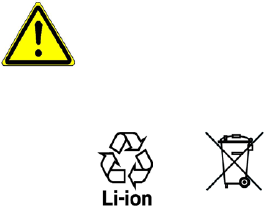
7
authorized service provider or local power company. For a
product that operates from battery power or other sources, refer
to the operating instructions that are included with the product.
This product should be operated only with the following designated power
supply unit(s).
AC Adapter
HTC, Model TC P300 and TC U250
Handle battery packs carefully
This product contains a Li-ion battery. There is a risk of fire and
burns if the battery pack is handled improperly. Do not attempt
to open or service the battery pack. Do not disassemble, crush,
puncture, short external contacts or circuits, dispose of in fire
or water, or expose a battery pack to temperatures higher than
60˚C (140˚F).
WARNING: Danger of explosion if battery is incorrectly
replaced. To reduce risk of fire or burns, do not disassemble,
crush, puncture, short external contacts, expose to temperature
above 60˚C (140˚F), or dispose of in fire or water. Replace only
with specified batteries. Recycle or dispose of used batteries
according to the local regulations or reference guide supplied
with your product.
NOTE: This prOducT shOuld bE OpEraTEd ONly wiTh ThE fOllOwiNg dEsigNaTEd baTTEry
pack(s).
hTc, MOdEl bb96100 & bTr6300b
•
8
Take extra precautions
Keep the battery or device dry and away from water or
any liquid as it may cause a short circuit.
Keep metal objects away so they don’t come in contact
with the battery or its connectors as it may lead to short
circuit during operation.
The phone should be only connected to products that
bear the USB-IF logo or have completed the USB-IF
compliance program.
Do not use a battery that appears damaged, deformed,
or discolored, or the one that has any rust on its casing,
overheats, or emits a foul odor.
Always keep the battery out of the reach of babies and
small children, to avoid swallowing of the battery. Consult
the doctor immediately if the battery is swallowed.
Only use the battery with a charging system that has been
qualified with the system per this standard, IEEE-Std-
1725-2006. Use of an unqualified battery or charger may
present a risk of fire, explosion, leakage or other hazard.
Replace the battery only with another battery that has
been qualified with the system per this standard, IEEE-
Std-1725-2006. Use of an unqualified battery may present
a risk of fire, explosion, leakage or other hazard.
Avoid dropping the phone or battery. If the phone or
battery is dropped, especially on a hard surface, and
the user suspects damage, take it to a service centre for
inspection.
If the battery leaks:
•
•
•
•
•
•
•
•
•
•
9
Do not allow the leaking fluid to come in contact
with skin or clothing. If already in contact, flush the
affected area immediately with clean water and seek
medical advice.
Do not allow the leaking fluid to come in contact
with eyes. If this occurs, DO NOT rub; rinse with clean
water immediately and seek medical advice.
Take extra precautions to keep a leaking battery away
from fire as there is a danger of ignition or explosion.
SAFETY PRECAUTIONS FOR DIRECT SUNLIGHT
Keep this product away from excessive moisture and extreme
temperatures. Do not leave the product or its battery inside a vehicle
or in places where the temperature may exceed 60˚C (140˚F), such
as on a car dashboard, window sill, or behind a glass that is exposed
to direct sunlight or strong ultraviolet light for extended periods of
time. This may damage the product, overheat the battery, or pose a
risk to the vehicle.
PREVENTION OF HEARING LOSS
CAUTION: Permanent hearing loss may occur if earphones or
headphones are used at high volume for prolonged periods of
time.
SAFETY IN AIRCRAFT
Due to the possible interference caused by this product to an
aircraft’s navigation system and its communications network, using
this device’s phone function on board an airplane is against the law
in most countries. If you want to use this device when on board an
aircraft, remember to turn off your phone by switching to Airplane
Mode.
•
•
•
10
ENVIRONMENT RESTRICTIONS
Do not use this product in gas stations, fuel depots, chemical
plants or where blasting operations are in progress, or in potentially
explosive atmospheres such as fuelling areas, fuel storehouses, below
deck on boats, chemical plants, fuel or chemical transfer or storage
facilities, and areas where the air contains chemicals or particles, such
as grain, dust, or metal powders. Please be aware that sparks in such
areas could cause an explosion or fire resulting in bodily injury or
even death.
EXPLOSIVE ATMOSPHERES
When in any area with a potentially explosive atmosphere or where
flammable materials exist, the product should be turned off and
the user should obey all signs and instructions. Sparks in such areas
could cause an explosion or fire resulting in bodily injury or even
death. Users are advised not to use the equipment at refueling points
such as service or gas stations, and are reminded of the need to
observe restrictions on the use of radio equipment in fuel depots,
chemical plants, or where blasting operations are in progress. Areas
with a potentially explosive atmosphere are often, but not always,
clearly marked. These include fueling areas, below deck on boats,
fuel or chemical transfer or storage facilities, and areas where the air
contains chemicals or particles, such as grain, dust, or metal powders.
ROAD SAFETY
Vehicle drivers in motion are not permitted to use telephony services
with handheld devices, except in the case of emergency. In some
countries, using hands-free devices as an alternative is allowed.
SAFETY PRECAUTIONS FOR RF EXPOSURE
Avoid using your phone near metal structures (for example, the
steel frame of a building).
•
11
Avoid using your phone near strong electromagnetic sources,
such as microwave ovens, sound speakers, TV and radio.
Use only original manufacturer-approved accessories, or
accessories that do not contain any metal.
Use of non-original manufacturer-approved accessories may
violate your local RF exposure guidelines and should be avoided.
•
•
•
12
INTERFERENCE WITH MEDICAL EQUIPMENT FUNCTIONS
This product may cause medical equipment to malfunction. The use
of this device is forbidden in most hospitals and medical clinics.
If you use any other personal medical device, consult the
manufacturer of your device to determine if they are adequately
shielded from external RF energy. Your physician may be able to
assist you in obtaining this information.
Turn your phone OFF in health care facilities when any regulations
are posted. Hospitals or health care facilities may be using equipment
that could be sensitive to external RF energy.
HEARING AIDS
Some digital wireless phones may interfere with some hearing aids. In
the event of such interference, you may want to consult your service
provider, or call the customer service line to discuss alternatives.
NONIONIZING RADIATION
Your device has an internal antenna. This product should be operated
in its normal-use position to ensure the radiative performance and
safety of the interference. As with other mobile radio transmitting
equipment, users are advised that for satisfactory operation of the
equipment and for the safety of personnel, it is recommended that no
part of the human body be allowed to come too close to the antenna
during operation of the equipment.
Use only the supplied integral antenna. Use of unauthorized
or modified antennas may impair call quality and damage the
phone, causing loss of performance and SAR levels exceeding the
recommended limits as well as result in non-compliance with local
regulatory requirements in your country.
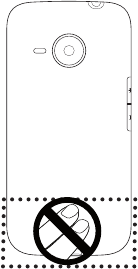
13
To assure optimal phone performance and
ensure human exposure to RF energy is
within the guidelines set forth in the relevant
standards, always use your device only in
its normal-use position. Contact with the
antenna area may impair call quality and
cause your device to operate at a higher
power level than needed. Avoiding contact
with the antenna area when the phone is IN
USE optimizes the antenna performance and
the battery life.
General Precautions
• Avoid applying excessive pressure to the device
Do not apply excessive pressure on the screen and the device
to prevent damaging them and remove the device from your
pants’ pocket before sitting down. It is also recommended that
you store the device in a protective case and only use the device
stylus or your finger when interacting with the touch screen.
Cracked display screens due to improper handling are not
covered by the warranty.
• Device getting warm after prolonged use
When using your device for prolonged periods of time, such
as when you’re talking on the phone, charging the battery or
browsing the web, the device may become warm. In most cases,
this condition is normal and therefore should not be interpreted
as a problem with the device.
14
• Heed service markings
Except as explained elsewhere in the Operating or Service
documentation, do not service any product yourself. Service
needed on components inside the device should be done by an
authorized service technician or provider.
• Damage requiring service
Unplug the product from the electrical outlet and refer servicing
to an authorized service technician or provider under the
following conditions:
Liquid has been spilled or an object has fallen onto the
product.
The product has been exposed to rain or water.
The product has been dropped or damaged.
There are noticeable signs of overheating.
The product does not operate normally when you follow the
operating instructions.
• Avoid hot areas
The product should be placed away from heat sources such as
radiators, heat registers, stoves, or other products (including
amplifiers) that produce heat.
• Avoid wet areas
Never use the product in a wet location.
• Avoid using your device after a dramatic change in temperature
When you move your device between environments with very
different temperature and/or humidity ranges, condensation
may form on or within the device. To avoid damaging the device,
allow sufficient time for the moisture to evaporate before using
the device.
•
•
•
•
•
15
NOTICE: When taking the device from low-temperature conditions into a
warmer environment or from high-temperature conditions into
a cooler environment, allow the device to acclimate to room
temperature before turning on power.
Avoid pushing objects into product
Never push objects of any kind into cabinet slots or other
openings in the product. Slots and openings are provided for
ventilation. These openings must not be blocked or covered.
• Mounting accessories
Do not use the product on an unstable table, cart, stand,
tripod, or bracket. Any mounting of the product should follow
the manufacturer’s instructions, and should use a mounting
accessory recommended by the manufacturer.
• Avoid unstable mounting
Do not place the product on an unstable base.
• Use product with approved equipment
This product should be used only with personal computers and
options identified as suitable for use with your equipment.
• Adjust the volume
Turn down the volume before using headphones or other audio
devices.
• Cleaning
Unplug the product from the wall outlet before cleaning. Do not
use liquid cleaners or aerosol cleaners. Use a damp cloth for
cleaning, but NEVER use water to clean the LCD screen.
•
16
Contents
Chapter 1 Phone Basics 26
1.1 Your Phone and Accessories ...........................................................................26
Front panel .........................................................................................................26
Back panel .......................................................................................................... 27
Left panel ............................................................................................................ 27
Top panel ............................................................................................................ 28
Bottom panel ..................................................................................................... 28
What’s inside the box ..................................................................................... 28
1.2 Installing the Battery and Storage Card ....................................................29
Battery .................................................................................................................29
Storage card ....................................................................................................... 31
1.3 Charging the Battery ......................................................................................... 32
1.4 Phone Controls .................................................................................................... 33
Search button .................................................................................................... 35
1.5 Getting Around Your Phone ........................................................................... 35
Tap ......................................................................................................................... 35
Press and hold ..................................................................................................36
Swipe or slide ....................................................................................................36
Drag ......................................................................................................................36
Flick .......................................................................................................................36
Rotate ...................................................................................................................36
Pinch ..................................................................................................................... 37
Using the Trackball .......................................................................................... 37
17
1.6 Getting Started .................................................................................................... 37
Turning your phone on and off................................................................... 37
Setting up your phone for the first time ................................................. 38
Turning off the screen when not in use ...................................................39
1.7 Home Screen .........................................................................................................41
Extended Home screen .................................................................................42
Customizing the Home screen ...................................................................42
1.8 Phone Status, Notifications, and Proximity Sensor ...............................46
Notifications panel ..........................................................................................48
Notification LED ...............................................................................................49
Proximity Sensor ..............................................................................................49
1.9 Applications ..........................................................................................................50
Recently-used applications..........................................................................50
1.10 Settings ..................................................................................................................51
1.11 Adjusting the Volume ....................................................................................... 52
1.12 Using the Phone’s Storage Card as a USB Drive ...................................54
Chapter 2 Using Phone Features 55
2.1 Making Calls .......................................................................................................... 55
Calling using the phone dialer screen ..................................................... 55
Calling using Voice Dialer ............................................................................. 57
Calling a phone number in a text message ........................................... 57
Calling a speed dial number ........................................................................58
Calling a phone number in an email .........................................................58
Making an emergency call ............................................................................58
2.2 Answering or Rejecting a Call ....................................................................... 59
Answering an incoming call .........................................................................59
Rejecting an incoming call ...........................................................................59
Muting the ringing sound .............................................................................59
Rejecting a call and sending a text message ........................................60
18
2.3 Using In-call Options ........................................................................................60
Handling multiple calls ................................................................................... 61
Setting up a conference call ......................................................................... 61
Muting the microphone during a call .......................................................62
Turning the speakerphone on or off.........................................................62
Ending a call .....................................................................................................62
2.4 Using Call History .............................................................................................. 63
Using the Call History tab ............................................................................. 63
Adding a new phone number to Contacts ............................................64
Checking a missed call ..................................................................................64
Clearing the Call History list ........................................................................64
2.5 Adjusting Phone Settings ...............................................................................65
2.6 Turning the Phone Function On and Off ..................................................66
Enabling or disabling Airplane mode ......................................................66
Chapter 3 Using People 67
3.1 About People ........................................................................................................ 67
People widget ................................................................................................... 67
Contact sources ...............................................................................................68
3.2 Using the People screen .................................................................................69
Setting up My contact card .........................................................................70
Viewing and managing contacts ...............................................................70
Using Favorites ................................................................................................. 73
Working with Groups ..................................................................................... 74
3.3 Using Facebook and Flickr in People.........................................................76
3.4 Using the Contact Details screen ................................................................ 79
19
Chapter 4 Entering Text 82
4.1 Using the Onscreen Keyboard .......................................................................82
Using the landscape onscreen keyboard ............................................... 82
QWERTY .............................................................................................................83
Compact QWERTY .........................................................................................84
Phone keypad ................................................................................................... 85
4.2 Entering Numbers and Symbols ..................................................................86
4.3 Adjusting Touch Input Settings .................................................................... 87
Touch Input settings ....................................................................................... 87
Text input ............................................................................................................ 87
Chapter 5 Exchanging Messages 89
5.1 Sending Text and Multimedia Messages ....................................................89
Opening Messages ..........................................................................................89
Creating and sending SMS and MMS messages ..................................90
Receiving text and multimedia messages ..............................................94
Managing messages and message threads ...........................................95
Setting text and multimedia message options .................................... 97
Adding the Messages widget......................................................................98
5.2 Using Mail ..............................................................................................................99
Adding a POP3/IMAP email account .......................................................99
Adding a Microsoft Exchange ActiveSync account ...........................99
Synchronizing Exchange ActiveSync emails.......................................100
Changing Exchange ActiveSync settings .............................................100
Creating another email account ..............................................................100
Composing and sending emails ................................................................ 101
Viewing and replying to emails ................................................................ 102
Managing emails on your external email account ............................. 103
Editing email account settings .................................................................104
Sending a meeting request using the Exchange
ActiveSync account ...................................................................................... 105
20
Deleting an email account .......................................................................... 105
Adding the Mail widget ............................................................................... 105
Chapter 6 Getting Connected 106
6.1 Connecting to the Internet ............................................................................ 106
6.2 Data Connection .............................................................................................. 106
6.3 Wi-Fi ..................................................................................................................... 106
Turning Wi-Fi on and connecting to a wireless network................ 107
Checking the wireless network status ................................................... 107
6.4 Using Browser ...................................................................................................109
Opening Browser ........................................................................................... 109
Going to a web page ....................................................................................109
Setting your home page ............................................................................. 109
Changing the screen orientation .............................................................. 110
Browsing classic views (not mobile version) of web pages .......... 110
Navigating on a web page .......................................................................... 110
Zooming in or out on a web page............................................................ 110
Opening a new browser window ................................................................111
Switching between browser windows .....................................................112
Finding text within a web page .................................................................112
Selecting links in web pages .......................................................................113
Downloading web applications ................................................................. 114
Managing bookmarks .....................................................................................115
Setting Browser options ...............................................................................116
6.5 Using Bluetooth..................................................................................................116
Turning on Bluetooth and making the phone discoverable ............117
Changing the phone name ...........................................................................117
Pairing and connecting with a Bluetooth hands-free
headset or car kit .............................................................................................117
Disconnecting a Bluetooth hands-free headset or car kit ...............119
21
Chapter 7 Camera and Multimedia 121
7.1 Using Camera and Camcorder .......................................................................121
Opening Camera ..............................................................................................121
Closing Camera ...............................................................................................122
Changing capture modes ............................................................................123
Taking pictures .................................................................................................123
Shooting videos ..............................................................................................124
Review screen ..................................................................................................125
Camera menu panel ......................................................................................125
7.2 Using Albums ......................................................................................................127
Opening Albums .............................................................................................127
Working with pictures...................................................................................128
Working with videos ......................................................................................133
Adding the Photo album or Photo frame widget ..............................135
Closing Albums ...............................................................................................135
7.3 Using Music ..........................................................................................................135
Copying music on to the storage card ...................................................135
Opening Music ................................................................................................ 136
Playing music .................................................................................................. 136
Listening to music on the Lock screen ...................................................137
Library .................................................................................................................137
Creating playlists ............................................................................................138
Managing your playlists ................................................................................139
Setting a song as ringtone .........................................................................140
Adding the Music widget............................................................................140
22
Chapter 8 Google Apps 141
8.1 Signing In to Your Google Account .............................................................141
Retrieving your Google Account password ..........................................141
8.2 Using Gmail ....................................................................................................... 142
Creating and sending emails ..................................................................... 143
Receiving and reading emails ................................................................... 145
Replying to or forwarding emails .............................................................147
Managing conversations and emails .......................................................147
Setting Gmail settings ................................................................................. 149
8.3 Using Google Talk ............................................................................................ 150
Signing in and chatting online .................................................................. 150
Managing your friends ..................................................................................153
Mobile indicators ............................................................................................ 154
Adjusting instant messaging settings .....................................................155
Signing out ....................................................................................................... 156
8.4 Using Google Maps ......................................................................................... 156
Searching for places of interest ................................................................157
Viewing maps ...................................................................................................158
Getting directions ..........................................................................................160
8.5 Using Google Latitude .....................................................................................161
Opening Latitude ............................................................................................162
Sharing your locations ..................................................................................162
Inviting friends .................................................................................................162
Accepting an invitation ................................................................................163
Showing your friends ....................................................................................163
Connecting with your friends ................................................................... 164
Controlling what you share ........................................................................ 165
8.6 Using YouTube ...................................................................................................167
Watching videos .............................................................................................167
Searching for videos ..................................................................................... 168
Sharing videos ................................................................................................ 169
23
8.7 Using Android Market .................................................................................... 169
Opening Android Market ............................................................................ 169
Getting help ..................................................................................................... 170
Finding applications ..................................................................................... 170
Installing and opening an application ......................................................171
Managing applications ..................................................................................173
Uninstalling an application ..........................................................................174
8.8 Synchronizing Google Apps .........................................................................174
Chapter 9 Other Applications 176
9.1 Using Calendar ....................................................................................................176
Opening Calendar ..........................................................................................176
Creating events ...............................................................................................176
Calendar views .................................................................................................178
Event reminders ..............................................................................................179
Synchronizing Exchange ActiveSync Calendar ................................. 180
Synchronizing Outlook Calendar ............................................................. 180
Adding the Calendar widget .......................................................................181
9.2 Using Clock ..........................................................................................................181
Opening Clock ..................................................................................................181
Setting the local date, time zone, and time ..........................................182
Adding cities to the world clock list ........................................................182
Setting your home city’s date and time ...............................................183
Setting an alarm ..............................................................................................183
Deleting an alarm .......................................................................................... 184
Using Stopwatch and Timer ...................................................................... 184
Adding the Clock widget ............................................................................ 184
9.3 Using HTC Sync ................................................................................................ 184
Installing HTC Sync on your PC .................................................................185
Setting up HTC Sync to synchronize Outlook items .........................185
Synchronizing Outlook items .....................................................................187
24
Resolving conflicts between the phone and PC ................................ 188
Opening Sync Manager help ..................................................................... 188
Installing Android applications ............................................................... 188
9.4 Using HTC Footprints .................................................................................... 189
Creating a Footprint ..................................................................................... 189
Revisiting a Footprint .................................................................................. 190
Editing or deleting a Footprint................................................................. 190
Backing up your Footprints .........................................................................191
Adding the Footprint widget ......................................................................191
9.5 Using PDF Viewer ..............................................................................................191
Viewing a PDF file ...........................................................................................191
9.6 Using Peep ..........................................................................................................193
Opening Peep ..................................................................................................193
Sending a tweet ............................................................................................. 194
Sending a direct message .......................................................................... 194
Searching for Twitter users to follow ......................................................195
Adding the Twitter widget ..........................................................................195
9.7 Using Quickoffice ............................................................................................. 196
Viewing documents, presentations and spreadsheets ................... 196
9.8 Using Stocks ...................................................................................................... 198
Opening Stocks .............................................................................................. 198
Adding a stock quote or stock market index ..................................... 198
Changing the list order ............................................................................... 199
Deleting an item ............................................................................................. 199
Adding the Stocks widget.......................................................................... 199
9.9 Using Weather .................................................................................................. 199
Opening Weather .......................................................................................... 199
Displaying weather in your location ......................................................200
Adding a city ................................................................................................... 201
Changing Weather options ........................................................................ 201
25
Changing the order of cities ...................................................................... 201
Deleting a city ................................................................................................. 201
Adding the Weather widget ..................................................................... 202
9.10 Using Voice Recorder .................................................................................. 202
Recording your voice .................................................................................. 202
Setting a voice clip as a ringtone ........................................................... 202
Renaming a voice clip ................................................................................. 203
Chapter 10 Managing Your Phone 204
10.1 Changing Basic Settings .............................................................................204
Setting the date and time .........................................................................204
Display settings ............................................................................................. 204
Ringer settings ............................................................................................... 205
Phone services ............................................................................................... 206
Language settings ........................................................................................ 207
Social network settings .............................................................................. 207
10.2 Protecting Your Phone ................................................................................ 208
Protecting your phone with a screen lock .......................................... 208
10.3 Managing Memory ......................................................................................... 210
10.4 Resetting the Phone .......................................................................................211
Appendix 212
A.1 Specifications......................................................................................................212
A.2 Regulatory Notices ..........................................................................................213
A.3 Additional Safety Information ....................................................................222
Index 232
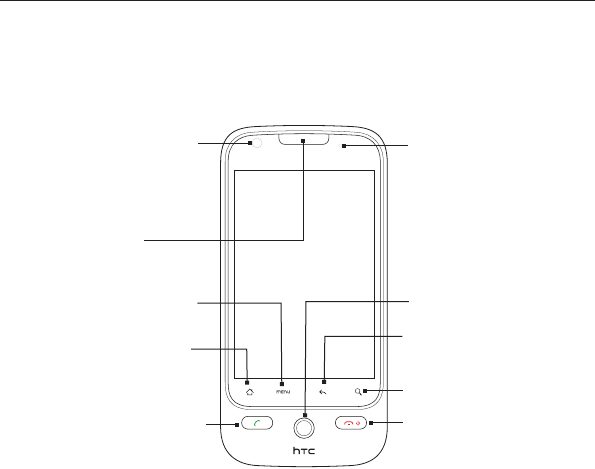
1.1 Your Phone and Accessories
Front panel
Notification LED
See “Phone Status
and Notifications”
in this chapter for
details.
Touch Screen
HOME
END/POWER
BACK
TRACKBALL
CALL
MENU
Earpiece
Listen to a phone
call from here.
SEARCH
Proximity Sensor
Chapter 1
Phone Basics
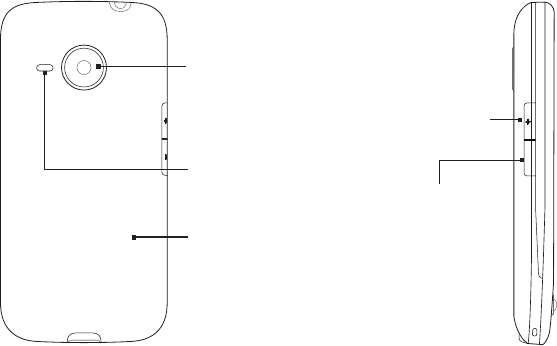
Phone Basics 27
For more information about the functions of the MENU, HOME, CALL,
END/POWER, SEARCH, and BACK buttons, see “Phone Controls”
in this chapter. For more information about the TRACKBALL, see
“Using the Trackball” in this chapter. For more information about the
proximity sensor, see “Proximity Sensor” in this chapter.
Back panel Left panel
Back Cover
See “To remove the
back cover” in this
chapter.
5 Megapixel Camera
See “Using Camera
and Camcorder ” in
Chapter 7 for details.
Speaker
VOLUME UP
Press to increase
the ringer or
media volume.
VOLUME DOWN
Press to lower
the ringer or
media volume.
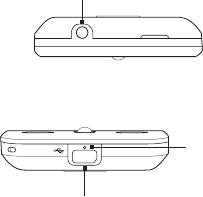
28 Phone Basics
Top panel 3.5 mm Audio Jack
Connect a headset (not included in
the box) for hands-free conversation
or for listening to audio media.
Bottom panel
USB Connector/Earphone Jack
Connect the:
USB cable to transfer files.
AC adapter to recharge the battery.
USB stereo headset for hands-free
conversation or for listening to music
(not included in box).
•
•
•
Microphone
What’s inside the box
The product package includes the following items and accessories:
Phone
Battery
Wall/USB Charger
8 GB microSD™ card
(pre-installed)
•
•
•
•
Quick Start Guide
RF Brochure
Product Safety and Warranty Brochure
•
•
•
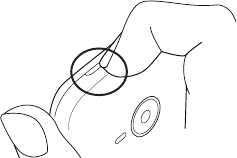
Phone Basics 29
1.2 Installing the Battery and Storage Card
Always turn off your phone before installing or replacing the battery
and storage card. You also need to remove the back cover before you
can install the battery and storage card.
Note The microSD card is pre-installed in the phone.
To remove the back cover
1. Make sure the phone is turned
off.
2. Hold the device securely with
the front facing down.
3. With your thumb or finger, lift
up the top (from the notch) of
the back cover.
Battery
Your phone comes with a rechargeable Lithium-ion battery and is
designed to use only manufacturer-specified original batteries and
accessories. Battery performance depends on many factors, including
network configuration, signal strength, the temperature of the
environment in which you operate your phone, the features and/or
settings you select and use, items attached to connecting ports, and
your voice, data, and other program usage patterns.
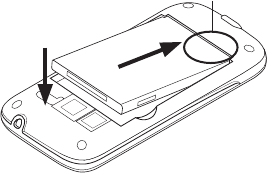
30 Phone Basics
Battery life estimates (approximations):
Talk time: Up to 214 minutes
Standby time: Up to 373 hours
Note Battery life is subject to network and phone usage.
Warning! To reduce risk of fire or burns:
• Do not attempt to open, disassemble, or service the battery
pack.
• Do not crush, puncture, short external contacts, or dispose of in
fire or water.
• Do not expose to temperatures above 140oF (60oC).
• Replace only with the battery pack designated for this product.
• Recycle or dispose of used battery as stipulated by local
regulations.
To install the battery
1. Align the battery’s exposed
copper contacts with the
battery connectors inside
the battery compartment.
2. Insert the contact side of
the battery first then gently
push the battery into place.
3. Replace the back cover.
Battery contacts
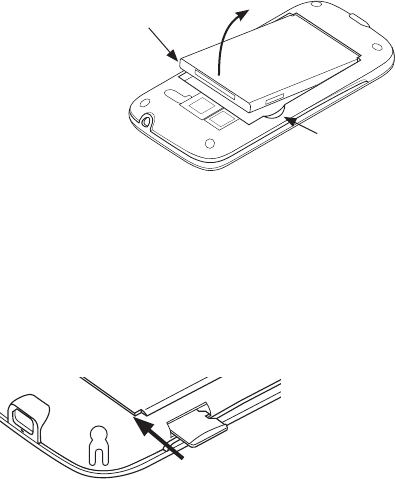
Phone Basics 31
To remove the battery
1. Make sure your phone is
turned off.
2. Remove the back cover.
3. Lift out the battery from
the notches at the upper
right and left sides of the
battery compartment.
Notch
Notch
Storage card
Store your pictures, music, and applications on the microSD™ card of
your phone.
To install the storage card
1. Remove the back cover.
2. Insert the microSD card into the slot with its gold contacts facing
down.
3. Press the microSD card all the way in until it clicks into place.
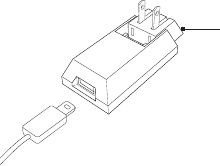
32 Phone Basics
To remove the storage card
Press the storage card in to eject it from the slot.
Note If you want to remove the storage card while the phone is on, see
“To remove the storage card while the phone is on” later in this chapter.
1.3 Charging the Battery
New batteries are not charged when shipped. Before you start using
your phone, you need to install and charge the battery. Some batteries
perform best after several full charge/discharge cycles.
To charge the battery
1. Connect the USB connector of the Charging Cable to the sync
connector on the bottom of your phone.
2. Connect the other end of the Charging Cable to the AC Charger.
3. Select the AC Charger plug adapter that is appropriate for your
locale and insert it into the AC Charger.
AC charger
adapter plug
4. Plug in the AC Charger to an electrical outlet to start charging
the battery.
Note Only the AC adapter and USB cable provided with your phone must be
used to charge the battery.
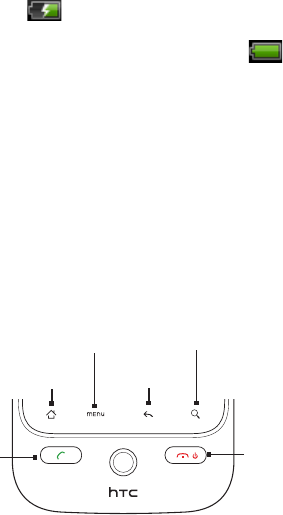
Phone Basics 33
Charging is indicated by a solid amber light in the Notification LED.
As the battery is being charged while the phone is on, the charging
battery icon ( ) is displayed in the status bar of the Home screen.
After the battery has been fully charged, the Notification LED shows
a solid green light and a full battery icon ( ) displays in the status
bar of the Home screen.
For more information about the Notification LED, see “Phone Status
and Notifications” in this chapter.
Warning! • Do not remove the battery from the phone while you are
charging it.
• As a safety precaution, the battery stops charging when it
overheats.
1.4 Phone Controls
Press the control buttons on the front panel of your phone to do the
following:
SEARCHMENU
CALL
BACKHOME
END/POWER
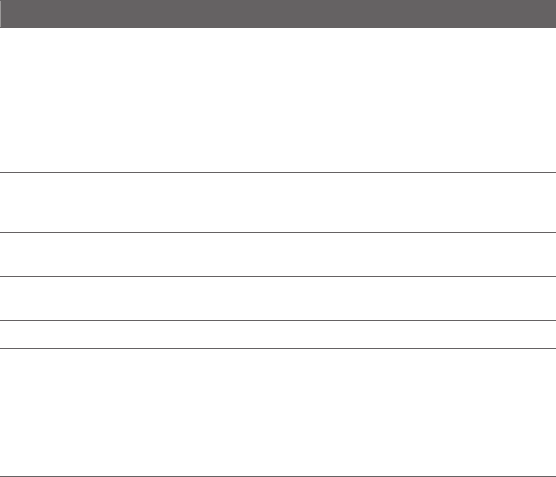
34 Phone Basics
Button Function
CALL Press to open the phone dialer screen.
When a contact, contact number, or phone number is
highlighted on the screen, press to call the contact or phone
number.
During a call, press and hold to turn on speakerphone.
Press and hold again to turn off speakerphone.
If you navigated to another application during a call, press to
display the ongoing call on the screen.
•
•
•
•
HOME While on any application or screen, press to return to the Home
screen.
Press and hold to open the recently-used applications window.
•
•
MENU Press to open a list of actions that you can do on the current
screen or options menu.
BACK Press to go back to the previous screen, or to close a dialog box,
options menu, the Notifications panel, or onscreen keyboard.
SEARCH See “Search button” later in this chapter for details.
END/
POWER
To end a call, press to hang up.
In standby mode, press to turn off the screen and lock the
phone.
In standby mode, press and hold to open the phone options
menu that lets you turn on/off Mobile network connection, turn
off the phone, or switch your phone to silent mode, vibration
mode, or airplane mode.
•
•
•
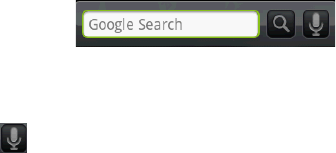
Phone Basics 35
Search button
Press SEARCH to search information on the current screen or
application. For example, while in the People, press SEARCH to search
for a contact in the phone.
Press SEARCH while in Maps to search for places of interest. Press
SEARCH while in the Home screen or Browser to launch Google™
search and search for information on the web.
In any search bar, enter the information you want to search, and then
press SEARCH again. You can also use your voice to search.
To search by voice
1. Tap .
2. When you see Speak now on the screen, say your search item
using a clear voice.
1.5 Getting Around Your Phone
There are different ways to navigate around the Home screen, menus
and application screens on your phone.
Tap
When you want to type using the onscreen keyboard, select items
onscreen such as application and settings icons, or press onscreen
buttons, simply tap them with your finger.
36 Phone Basics
Press and hold
To open the available options for an item (e.g. contact or link in a web
page), simply press and hold the item.
Swipe or slide
To swipe or slide means to quickly drag your finger vertically or
horizontally across the screen.
Drag
Press and hold your finger with some pressure before you start
to drag. While dragging, do not release your finger until you have
reached the target position.
Flick
Flicking the screen is similar to swiping, except that you need to swipe
your finger in light, quicker strokes. This finger gesture is always in
a vertical direction, such as when flicking through the contacts or
message list.
Rotate
For most screens, you can automatically change the screen
orientation from portrait to landscape by turning the phone sideways.
When entering text, you can turn the phone sideways to bring up a
bigger keyboard. Refer to Chapter 4 for more details.
Note The Orientation check box in HOME > MENU > Settings > Sound &
display needs to be selected for the screen orientation to automatically
change.
Phone Basics 37
Pinch
For some applications, like Albums or Browser, you can “pinch” the
screen using 2 fingers (for example, thumb and index fingers) to zoom
in or zoom out when viewing a picture or a webpage.
Using the Trackball
Roll or press the TRACKBALL to select or highlight items on the
screen. The TRACKBALL also flashes when you receive an incoming
call or a notification.
1.6 Getting Started
Once you’ve installed your battery and microSD card, you can turn on
your phone and start using it.
Turning your phone on and off
To turn on the phone
Press END/POWER.
Note When you turn on the phone for the first time, you will be prompted to
sign in to your Google™ Account. For more information on how to set
up your phone for the first time, see “Setting up your phone for the first
time” in this chapter.
To turn off the phone
Press and hold END/POWER for a few seconds.
When the Phone options options menu appears, tap Power off.
Tap OK when prompted to turn off the phone.
1.
2.
3.
38 Phone Basics
Setting up your phone for the first time
When you turn on your phone for the first time, you will be given
options to let you quickly set up various accounts, such as Google™
Account, Facebook®, Flickr™, Twitter™, Microsoft® Exchange
ActiveSync, and other email accounts.
Notes • You need to be connected to the Internet, using Wi-Fi or data
connection, to set up accounts.
• Setting up some of the accounts does not give you access to all the
features of the application. For example, when you set up a Facebook
account, you will only be able to view your Facebook albums and
your friends’ albums. You can, however, download the Facebook
application from Android Market™ or use Browser to go to the
Facebook website.
• You do not need to set up all accounts to use the phone.
1. You may be asked to choose the language you want to use, view
tutorials, or set up a Wi-Fi connection in the following screens.
Tap Next or Skip to go to the next screen.
Note You will only be asked to set up a Wi-Fi connection if there is a
Wi-Fi connection available.
2. On the Set up accounts screen, choose which accounts you want
to set up. Tap Skip if you do not want to set up accounts.
To learn how to set up a Google Account, refer to Chapter 8.
To learn how to set up an Exchange ActiveSync account and
other email accounts, refer to Chapter 5.
After setting up an account, you will be taken back to the Set
up accounts screen. Tap Next when you are done setting up the
accounts.
3. On the Set up social network accounts screen, choose which
social network accounts you want to set up. Tap Skip if you do
not want to set up accounts.
•
•
Phone Basics 39
After setting up an account, you will be taken back to the Set
up social network accounts screen. Tap Next when you are done
setting up the accounts.
4. On the Location consent screen, select the check box to allow
Google’s location service to collect location data, and then tap
Next.
Notes • Some applications on your phone, such as World Clock and Weather,
require Google’s location service to automatically update the time
and weather information for your current location.
• Google’s location service connects to the Internet using your phone’s
data or Wi-Fi connection.
5. Tap Finish to finish the setup process and return to the Home
screen.
Turning off the screen when not in use
To save battery power, the phone automatically turns off the screen
when you leave it idle after a certain period of time. You will still be
able to receive messages and calls while the phone’s screen is off.
Tip For information on how to adjust the time before the screen turns off,
see “Display settings” in Chapter 10.
You can also turn off the screen by pressing END/POWER. Pressing
END/POWER or incoming calls will turn on the phone screen and
show the lock screen.
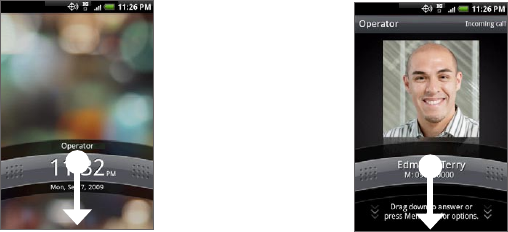
40 Phone Basics
To unlock the screen
Lock screen:
Incoming call
Lock screen
Press the bar on the
lock screen and then
slide your finger down
to unlock the screen or
answer an incoming call.
Tip You can also press MENU while on the lock screen to unlock the screen.
Note If you have set up a screen unlock pattern, you will be prompted to
draw the pattern on the screen before it unlocks. For more information
on how to create and enable the screen unlock pattern, see “Protecting
Your Phone” in Chapter 10.
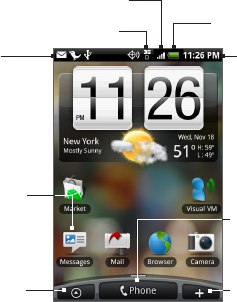
Phone Basics 41
1.7 Home Screen
The Home screen provides a lot of space to work with so you can
add the items you want and need on the Home screen. Add items like
application icons, shortcuts, folders, and HTC or Google widgets to
give you instant access to information and applications.
Notifications.
See “Phone Status
and Notifications”
in this chapter for
details.
Signal strength
Battery status
Connection status
Tap an icon to
open the related
application.
Tap to open or close the
All programs screen.
(See “Applications” in
this chapter for details.)
Time
Tap to open the phone
dialer screen.
Tap to add shortcuts,
widgets, and folders on
the Home screen.
Tip While in any application, press HOME to go back to the Home screen.
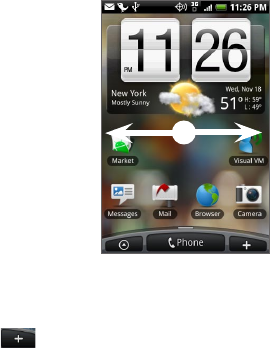
42 Phone Basics
Extended Home screen
The Home screen extends beyond
the screen width to provide more
space for adding icons, widgets, and
more. Press HOME, then slide your
finger horizontally across the screen
to go to the left or right side of the
extended Home screen. There are 6
“additional” screens apart from the
main Home screen.
Note You cannot add more screens.
Tip While on an extended Home
screen, press HOME to return to
the main Home screen.
Customizing the Home screen
To add a Home screen item
1. Press HOME, and then tap .
Note You can also press and hold an empty area on the Home screen.
2. When the Add to Home options menu opens, select the item you
want to add to the Home screen:
• Shortcut. Add shortcuts such as applications, a bookmarked
web page, a favorite contact, a Gmail™ label, a music playlist,
and more.
Tip To quickly add an application shortcut that is on the All programs
screen to the Home screen, press and hold an application icon.
When the phone vibrates, drag the icon on an empty area on the
Home screen, and then release it.
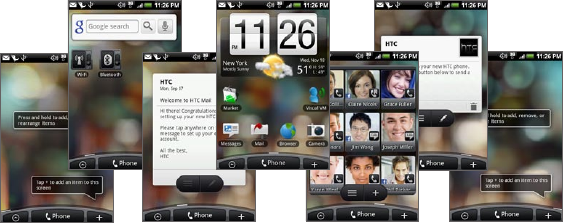
Phone Basics 43
• HTC widget. Add HTC widgets to the Home screen such as a
clock, calendar, mail, people, Footprints, and more.
• Android™ widget. Add Android widgets to the Home screen
such as a clock, music player, a picture frame, the Google™
search bar, or a calendar that shows upcoming appointments.
• Folder. Add a folder where you can organize Home screen
items. Add a shortcut to all your contacts, contacts with
phone numbers, or starred contacts (favorite contacts).
Contact details are automatically updated when there are
changes in the source. For more information on how to create
folders, see “To create a folder and add items to it” in this
chapter.
Your Home screen by default looks like this. Take advantage of the
available widgets or use Scenes to customize your Home screen.
To populate your Home screen with widgets from a Scene, press
HOME > MENU, and then tap Scenes.

44 Phone Basics
To add an HTC widget
1. Press HOME, and then tap .
2. In the Add to Home options menu, tap HTC widget.
3. Select a widget to add to the Home screen and then select the
layout to use.
Note Most HTC widgets offer various layouts and sizes to fit your needs.
4. Tap Select.
Note You may need to remove a widget on the Home screen first if there is no
space to place the new widget.
To reposition a Home screen item
1. Press and hold the item on the screen you want to reposition to
activate Edit mode.
Note When Edit mode is activated, the item magnifies and the phone
vibrates.
2. Without lifting your finger, drag the icon to the desired position
on the screen, then release it.
Note To move an item from the Home screen to an extended Home screen,
press and hold the item and then drag it to the left or right edge of the
screen until the display shifts to the extended Home screen. Position the
item on the screen, then release it.
To remove a Home screen item
1. Press and hold the item on the screen you want to remove to
activate Edit mode.
Note When Edit mode is activated, the item magnifies and the phone
vibrates.
2. Drag the icon to the Phone button (The Phone button changes
into .)
3. When the icon and the Remove button turn red, release it.
Phone Basics 45
To change the Home screen wallpaper
1. Press HOME > MENU, and then tap Wallpaper.
2. Select Home.
Note Select Lock screen to change the Lock screen wallpaper.
3. Tap Albums or Wallpaper gallery.
Tap Albums to use a picture that you have captured using the
camera or copied to your phone as a wallpaper. You can crop
the picture before setting it as a wallpaper. See “To crop a
picture” in Chapter 7 to learn how to crop the picture.
Tap Wallpaper gallery to use preset phone wallpapers.
4. Tap Save or Set wallpaper.
To create a folder and add items to it
You can create folders on the Home screen to hold application icons
or shortcuts.
1. Press HOME > MENU, and then tap Add to Home > Folder > New
folder. A new folder appears on the screen.
2. Press and hold an application icon or a shortcut on the Home
screen to activate Edit mode, then drag it on top of the folder.
To access the items inside a folder, tap the folder to open it and then
tap the icon of the application or shortcut you want to open.
Tip To delete a folder, follow the same procedure when you want to remove
a Home screen item. See “To remove a Home screen item” earlier in this
chapter.
To rename a folder
1. Tap the folder to open it.
2. Press and hold the folder’s title bar to open the Rename folder
dialog box.
3. Enter the Folder name and then tap OK.
•
•
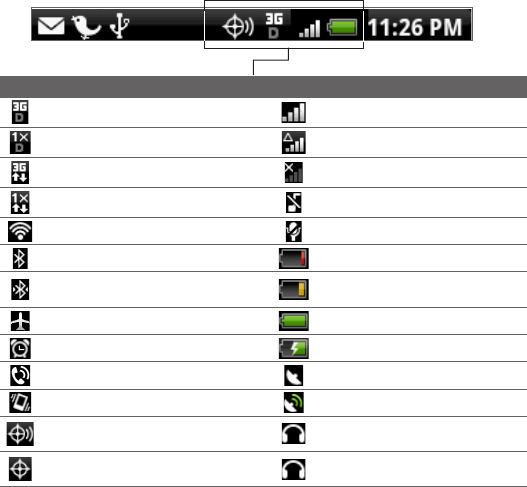
46 Phone Basics
1.8 Phone Status, Notifications, and Proximity
Sensor
Phone status icons
These are the icons that may appear on the phone status area of the
status bar:
Icons that appear in this area
EVDO available Signal strength
1xRTT available Roaming
EVDO in use No signal
1xRTT in use Phone speaker is mute
Connected to a Wi-Fi network Phone microphone is mute
Bluetooth is on Battery is very low
Connected to a Bluetooth
device Battery is low
Airplane mode on Battery is full
Alarm is set Battery is charging
Speakerphone on GPS is on
Vibrate mode GPS is connected
Location setting on Wired headset connected
Location setting off Wired headset connected
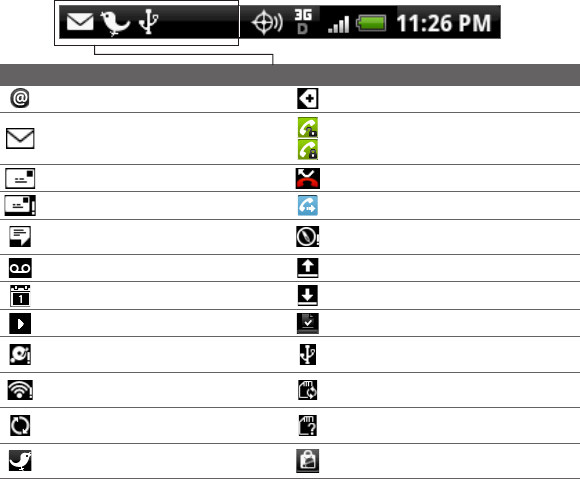
Phone Basics 47
Notification icons
These are the icons that may appear on the notifications area of the
status bar:
Icons that appear in this area
New Gmail message More (not displayed) notifications
New Microsoft Exchange
ActiveSync email or POP3/IMAP
message
Call in progress (Voice privacy
unlocked/locked)
New SMS/MMS Missed call
Problem with SMS/MMS delivery Call forwarding on
New instant message from
Google Talk Compass needs orientation
New voicemail Uploading data
Upcoming event Downloading data
Song is playing Content downloaded
Storage card is low on free space Phone connected to computer via
USB cable.
Wi-Fi is on and wireless networks
are available
Storage card is safe to remove or
storage card is being prepared
Data synchronizing or connected
to HTC Sync
No storage card installed on the
phone
New tweet Update available for an application
downloaded from Android Market
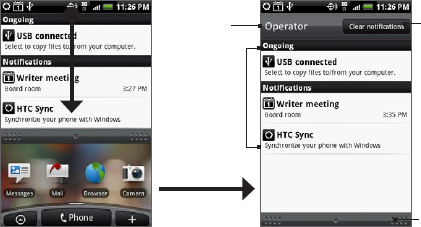
48 Phone Basics
Notifications panel
Notification icons report the arrival of new messages, calendar events,
alarms set and ongoing settings such as when call forwarding is on
or the current call status. You can open the Notifications panel to
open the message, reminder, or event notification and see the wireless
service provider name.
To open the Notifications panel
When a new notification icon displays in the status bar, press and
hold the status bar, then slide your finger downward to open the
Notifications panel.
Operator
name
Tap a
notification
to open
the related
application. Press and hold,
then slide up
to close the
Notifications
panel.
Tap to clear all
notifications.
If you have several notifications, you can scroll down the screen to
view more notifications.
Tip You can also open the Notifications panel on the Home screen by
pressing MENU and then tapping Notifications.
To close the Notifications panel
Press and hold the bottom bar of the Notifications panel, then slide
your finger up the screen or press BACK.
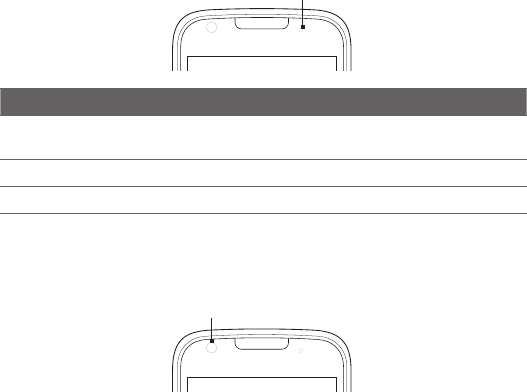
Phone Basics 49
Notification LED
The Notification LED located at the right corner of the earpiece
provides information on the phone status.
Notification LED
LED Status Indication
Solid green Battery is fully charged (when the phone is connected
to the AC adapter/computer).
Solid red Battery is charging.
Flashing red Battery is low.
Proximity Sensor
The proximity sensor automatically turns off the screen when there is
an object near the screen.
Proximity Sensor
The proximity sensor is useful when you are in a phone call and you
hold the phone near your ear. This turns off the screen automatically
to prevent accidental screen touches.
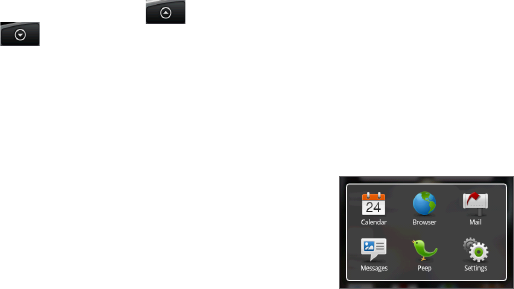
50 Phone Basics
1.9 Applications
The All programs screen holds all applications on your phone. All
applications that you downloaded and installed from Android Market
or from the web are also added to the All programs screen.
Important Some applications that are mentioned in the User Manual may not
be available on your phone by default. The applications available
on the phone depends on the region where you purchased the
phone.
To open the All programs screen
Press HOME, then tap . To close the All programs screen,
tap .
Tip To open applications quickly, you can add the icons of frequently-used
applications to the Home screen or to folders which you have created.
For details, see “Customizing the Home screen” earlier in this chapter.
Recently-used applications
To open a recently-used application
Press and hold HOME to open the
recently-used applications window.
The window displays the last six
applications you have used.
Tap an icon in the window to open the
related application.
1.
2.
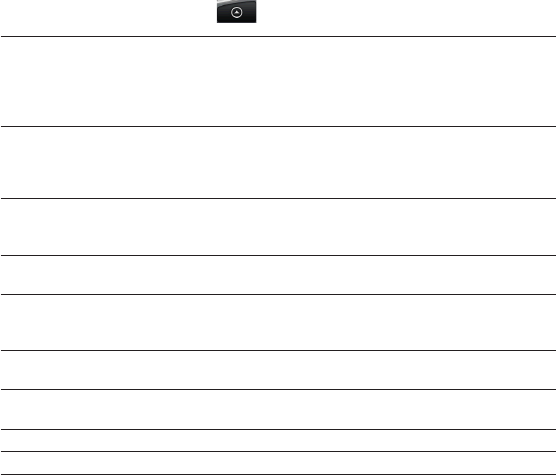
Phone Basics 51
1.10 Settings
Control and customize phone settings on the Settings screen.
To open the Settings screen, do one of the following:
Press HOME > MENU, and then tap Settings.
Press HOME, then tap > Settings.
Personalize Select a scene, set the Home screen or Lockscreen
wallpaper to use, and set the default ring tone to use for
incoming calls. You can also rename or delete a custom
scene by pressing and holding a custom scene while in the
Choose a Scene screen.
Wireless controls Configure your phone’s wireless connections, such as
Wi-Fi and Bluetooth, enable the Airplane mode, or set the
options for roaming, networks, and more. See Chapter 6 for
details.
Call settings Set up call services such as voice mail, Plus code dialing,
TTY support, Voice privacy, and more. See Chapter 2 for
details.
Sound & display Set the call and notification ring tones, or set the screen
brightness and screen timeout. See Chapter 10 for details.
Data
synchronization
Select Google Apps™, Exchange Activesync, and Microsoft®
Office Outlook® items, if set up, to synchronize. See
Chapters 5 and 9 for details.
Location Select the GPS location source to use and enable or disable
Location Setting.
Security Set the screen unlock pattern or reset the phone. See
Chapter 10 for details.
Social network Manage your Facebook, Flickr, and Twitter accounts.
Applications Manage applications and installation of new programs.
•
•
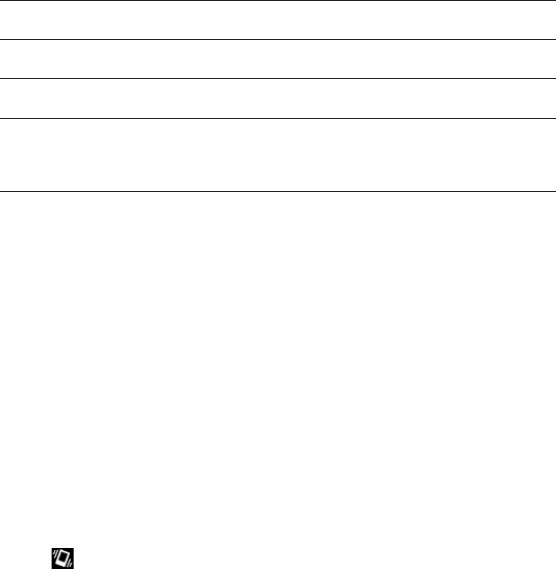
52 Phone Basics
SD card & phone
storage
Check the available storage card and phone memory. See
Chapter 10 for details.
Date & time Set the date and time, time zone, and date or time format.
See Chapter 9 for details.
Locale & text Set the operating system language and region. You can
also set onscreen keyboard options.
About phone View the phone status such as the network type, signal
strength, battery power level, and network name. You can
also view the legal information and software version of your
phone.
1.11 Adjusting the Volume
Adjusting the Ringer volume changes the volume level of the phone
ring tone, whereas adjusting the Media volume changes the volume
level of sound notifications and music or video playback. The ringer
volume and media volume can be separately adjusted.
To adjust the Ringer volume
You can adjust the Ringer volume when you are on the Home screen
or any application screens (except during a call or when playing
music/video).
Press the VOLUME UP or VOLUME DOWN buttons on the left
panel of the phone to adjust the ringer volume to your desired
level. The Ringer volume window appears on the screen to
display the volume levels. While in the lowest ringer volume level
(Silent mode), press VOLUME DOWN once to set your phone to
Vibrate mode. The phone vibrates and the vibrate mode icon
( ) appears on the status bar.
1.

Phone Basics 53
While in Vibrate mode, press VOLUME UP once to switch to silent
mode. The speaker mute icon ( ) displays on the status bar.
Tip To quickly switch your phone to silent mode, press and hold END/
POWER, then tap Silent mode on the options menu.
You can also adjust the ringer volume on the Settings screen.
To adjust, press HOME > MENU, and then tap Settings > Sound &
display > Ringer volume.
To adjust the media volume
When playing music or watching video, press the VOLUME UP or
VOLUME DOWN buttons on the left panel of the phone to adjust
the media volume. The Music/video volume window appears on the
screen to display the volume level.
You can also adjust the media volume on the Settings screen.
Press HOME > MENU, and then tap Settings.
Tap Sound & display > Media volume.
When the Media volume window appears, move the slider to the
left (to lower the volume) or to the right (to increase the volume).
Tap OK to close the window.
2.
1.
2.
3.
4.

54 Phone Basics
1.12 Using the Phone’s Storage Card as a USB
Drive
To transfer music, pictures, and other files from your computer to your
phone’s storage card, you need to set the phone’s storage card as a
USB drive.
To set the phone’s storage card as a USB drive
Connect the phone to the computer using the USB cable. A
notification icon ( ) appears in the status bar.
Open the Notifications panel. See “To open the Notifications
panel” earlier in this chapter to learn how to open the
Notifications panel.
In the Notifications panel, tap USB connected and then tap
Mount.
Note When you select Mount, the phone will not recognize the storage
card when it is connected to a computer. You will not be able to use
some of the phone’s applications such as Camera or Music.
To remove the storage card while the phone is on
When you need to remove the storage card while the phone is on,
you must unmount the storage card first to prevent corrupting or
damaging the storage card.
Press HOME > MENU, and then tap Settings.
Scroll down the screen, then tap SD card & phone storage.
Tap Unmount SD card.
Remove the storage card by following the instructions in
“To remove the storage card” earlier in this chapter.
1.
2.
3.
1.
2.
3.
4.
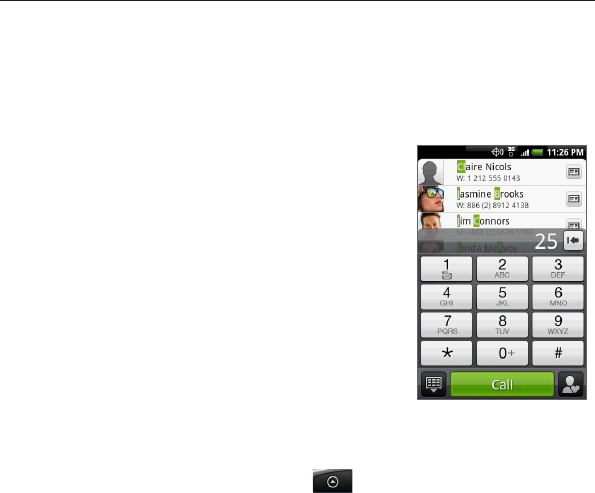
2.1 Making Calls
There are several convenient methods to make a call from your phone.
Calling using the phone dialer screen
You can either dial a number directly, or you
can use the Smart Dial feature to search and
call a contact in People or a number from or
Call History.
When you enter the first letter of the name
or number of a contact, Smart Dial searches
for contact phone numbers and the first
character of a contact name as well as from
the character that appears after a space, dash,
or underscore in a contact name. As you enter
more letters or numbers, the list shows only
the corresponding matches.
1. To open the phone dialer screen, do one of the following:
Press the CALL button.
Press HOME, and then tap > Phone.
•
•
Chapter 2
Using Phone Features
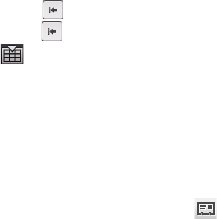
56 Using Phone Features
2. Begin entering the first few digits or characters by tapping the
keys on the Phone keypad. As you enter digits or letters, the
Smart Dial panel displays matches found. If you enter a wrong
digit, tap to erase that digit. To erase the entire number, press
and hold .
3. Tap to close the phone keypad and to see if there are more
matching numbers or contacts. To browse through the filtered
list, flick through the list or slide your finger up or down the list
slowly.
4. To call a number or contact, do one of the following:
• Tap the desired phone number or contact from the list.
• To call a different phone number associated with the contact,
tap the contact card icon at the right side of the contact
name. On the contact details screen, tap the number you want
to call.
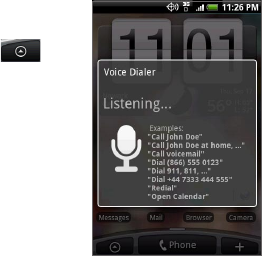
Using Phone Features 57
Calling using Voice Dialer
1. Do one of the following:
Press and hold the CALL button.
Press HOME, and then tap >
Voice Dialer.
2. When the Voice Dialer message box
appears and you see “Listening” on the
screen, say “Call [name of person]” in a
clear voice into the phone.
Note The person you want to call should be
in your People list.
3. A confirmation message will pop up
asking if the person to call is correct.
Tap OK if the person is correct or tap
Cancel to try again.
•
•
Calling a phone number in a text message
While viewing a text message, you can place a call to a number that is
in the body of the message.
1. Tap the message with the phone number.
2. On the Select link screen, tap the number you want to call.
3. The phone dialer screen then opens, with the phone number
automatically filled in and ready to be dialed. To place the call,
tap Call.
For more information about text messages, see Chapter 5.
58 Using Phone Features
Calling a speed dial number
To call a stored speed dial number, press and hold a number button.
For information on setting up speed dial numbers, see “To add a
contact to speed dial” in Chapter 3.
Calling a phone number in an email
While viewing a received email message, tap a phone number that is
displayed in the body of the email message to open the phone dialer
screen so you can call that number.
Making an emergency call
On the phone dialer screen, dial the international emergency number
for your locale (for example, 000), and then tap Call.
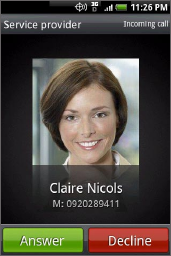
Using Phone Features 59
2.2 Answering or Rejecting a Call
When you receive a phone call from a contact,
the Incoming call screen appears and displays
the caller ID icon, name, and phone number
of the calling party. When you receive a
phone call from someone who is not stored in
Contacts, only the default caller ID icon and
phone number appear on the Incoming call
screen.
Answering an incoming call
Tap Answer or press the CALL button.
Important When the screen turns off during a call, press the TRACKBALL to
turn on the screen. DO NOT press END/POWER. Pressing END/
POWER will hang up the phone.
Rejecting an incoming call
Tap Decline or press END/POWER to reject and send the call to your
voice mail.
Muting the ringing sound
To mute the ring without rejecting the call, press the VOLUME DOWN
button.
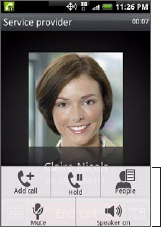
60 Using Phone Features
Rejecting a call and sending a text message
You can automatically send a default text message to the caller
and reject the incoming voice call. Press MENU and then tap Send
message when you have an incoming call to send the text message.
You can change the default text message by pressing MENU and then
tapping Phone settings > Edit default message while on the phone
dialer screen.
2.3 Using In-call Options
When a call is in progress, press
MENU to open the call options.
Tap the available buttons on the
call options menu to put a call
on hold, dial another contact for
a phone conference, mute the
phone microphone, and more.
Note When the phone is dialing,
only the People and Speaker
on buttons are available. Call options
Important When the screen turns off during a call, press the TRACKBALL to
turn on the screen. DO NOT press END/POWER. Pressing END/
POWER will hang up the phone.
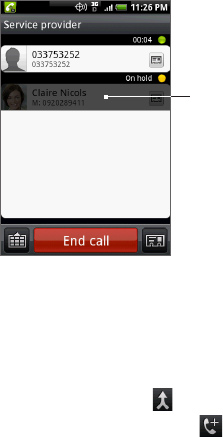
Using Phone Features 61
Handling multiple calls
Your phone notifies you when you have another incoming call, and
gives you the option of rejecting or accepting the call. If you are
already on a call and accept the new call, you can choose to switch
between the two callers.
1. Press the CALL button
to accept the second call
and put the first call on
hold.
2. To switch between callers,
tap the person you want
to talk to on the screen.
3. To end the current call
and return to the other
call, tap End call.
Tap to speak
to this caller
and put the
other call on
hold.
Setting up a conference call
1. Make a call to the first conference call participant.
2. When connected, press MENU, tap Add call, dial the number of
the second participant, and then tap Call. The first participant is
put on hold when you dial the second participant.
3. When connected to the second participant, tap (merge).
4. To add another participant to the conference call, tap on the
conference call screen, and then dial the number of the contact
you want to invite to the conference call.
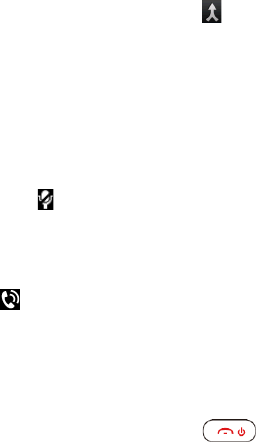
62 Using Phone Features
Note The conference call is put on hold when you call another contact.
When you are connected to the other contact, you can talk to that
party in private.
5. When connected, tap to add the participant to the conference
call.
6. When finished, tap End call.
Note Not all mobile phone networks support conference calling. Contact your
service provider for details.
Muting the microphone during a call
Press MENU, then tap Mute/Unmute to toggle between turning the
microphone on or off. When the microphone is turned off, the Mute
icon ( ) appears in the status bar.
Turning the speakerphone on or off
During a call, press MENU, then tap Speaker on/Speaker off to toggle
between turning the speakerphone on or off. The speakerphone icon
( ) appears in the status bar when the speakerphone is on.
Warning! To avoid damage to your hearing, do not hold your phone against
your ear when the speakerphone is turned on.
Ending a call
Do one of the following to end the call:
Press END/POWER ( ).
Tap End call.
If you are using the provided wired headset, press and hold the
button to end the call.
If the phone number of the person who called is not in your Contacts
list, you can choose to save the number after you hang up.
•
•
•
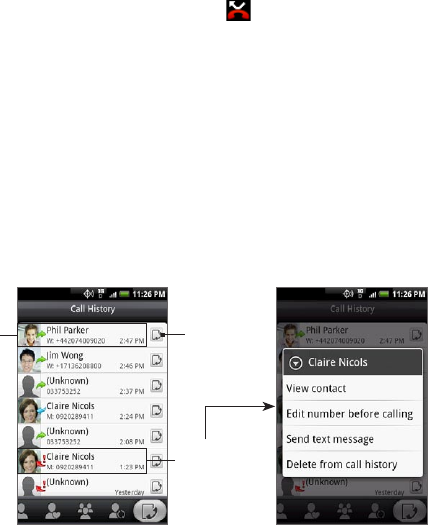
Using Phone Features 63
2.4 Using Call History
When you miss a call, the missed call icon ( )appears in the title
bar. Use the Call History tab of the People screen to check who the
caller was or view all your dialed numbers and received calls.
Using the Call History tab
Press CALL > MENU, and then tap Call history.
Do one of the following:
Tap the name or number in the list to call.
Press and hold a name or number in the list to display the
options menu where you can select to view the contact
information (if the number is stored in your contacts list), edit
the number before you redial, send a text message, or delete
from call history.
Tap to view
call history
for this
contact
only.
Press and
hold to
open the
options
menu.
Tap this area
to call the
contact.
1.
2.
•
•

64 Using Phone Features
Adding a new phone number to Contacts
If the phone number of a person who called is not in your contacts list,
you can choose to save the number after you hang up.
1. Press CALL > MENU, and then tap Call history.
2. Press and hold the received call that you want to save to your
contacts list, and then tap Save to contacts.
3. In the blank contact record that appears, enter the contact name
and other information. The phone number is automatically added
to the Mobile field in the Number section. To store it as another
type of number, for example a home number, tap the Mobile
button.
4. Scroll down the screen and tap Save.
Note For more information, see “To add a new contact” in Chapter 3.
Checking a missed call
You will see the missed call icon in the status bar when you miss a
call.
To check who the caller was, press CALL > MENU, and then tap Call
history. Missed calls are indicated by the missed call icon ( ).
Tip You can also press and hold the status bar, and then slide your finger
downward on the screen to open the Notifications panel. The missed
call number and/or contact name is displayed.
Clearing the Call History list
On the Call History tab, do one of the following:
To remove one name or number from the list, press and hold the
name or number, and then tap Delete from Call history.
To clear the entire list, press MENU and then tap Delete all.
•
•

Using Phone Features 65
2.5 Adjusting Phone Settings
You can adjust the phone settings of your phone such as your voice
mail number, Plus code dialing, Voice privacy, and more.
To open the phone settings menu, press HOME > MENU, and then tap
Settings > Call settings.
Options Description
Voicemail Specify the voice mail number.
Clear voicemail
notification
If you have a notification of a new voicemail, you can
clear the notification with this option.
Enable TTY
support
Enable TTY (Teletypewriter) support for your device.
Voice privacy Select to add another layer of encryption for outgoing
voice calls and to use secure channels when available.
Voice privacy
notification
Select to alert you if voice privacy is not available.

66 Using Phone Features
2.6 Turning the Phone Function On and Off
In many countries, you are required by law to turn off the phone while
on board an aircraft. A way to turn off the phone function is to switch
your phone to Airplane mode. When you enable Airplane mode, all
wireless radios on your phone are turned off, including the phone
function, Bluetooth, and Wi-Fi.
Enabling or disabling Airplane mode
1. Press HOME > MENU, then tap Settings > Wireless controls.
2. Select the Airplane mode check box to enable or disable
Airplane mode. When enabled, the Airplane mode icon ( )
displays in the status bar.
Tip When you disable Airplane Mode, the phone function is turned back on
and the previous state of Bluetooth and Wi-Fi is restored.

3.1 About People
In People, you can easily manage your communications with contacts
via phone, messaging, and email. You can also view updates on their
Facebook and Flickr accounts, as well as updating your own Facebook
status.
If you are synchronizing contacts with your Google account, with
your PC, and/or with an Exchange Server, any contacts stored in
those accounts are displayed in People. For more information on
synchronizing accounts, see “Contact sources” in this chapter.
To open People
Press HOME, then tap > People. When you open People, the
People screen is displayed.
People widget
The People widget allows you to get in touch with your favorite
contacts directly from the Home screen. See “Using Favorites” in this
chapter for more details. To learn how to add widgets, refer to “To add
an HTC widget” in Chapter 1.
Chapter 3
Using People
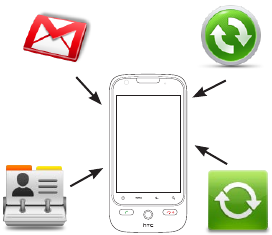
68 Using People
Note If your favorite contacts are contacts from your Google Account or
Exchange ActiveSync account, the People widget remembers your
favorite contacts even after you reset your phone. However, you will
need to set the default communication method for your favorite
contacts again. Refer to Chapter 10 to learn more about resetting your
phone.
Contact sources
You can add contacts to your phone from:
Gmail contacts
Gmail contacts are
imported to your
phone after you set
up a Google Account.
For details, see
Chapter 8.
Contacts on your PC
See “Using HTC Sync”
in Chapter 9.
Phone contacts
See “To add a new
contact” in this
chapter for details.
Exchange
ActiveSync Server
See Chapter 5 for
details.
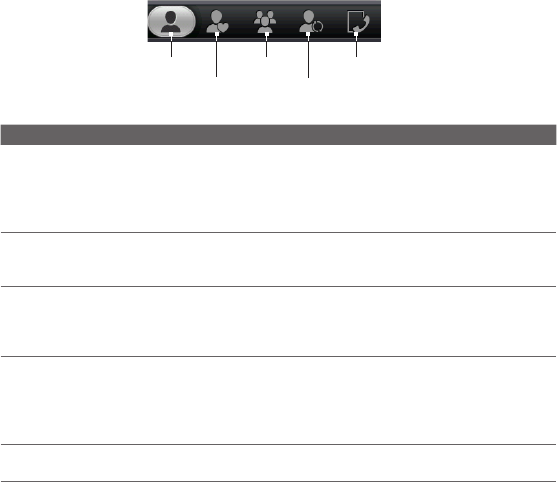
Using People 69
3.2 Using the People screen
The People screen gives you easy access to all your contacts, as well
as even faster access to the people and groups of people you contact
most often.
The People screen has the following tabs:
All
Favorites
Groups
Updates
and events
Call history
Tab Functions
All Gives you access to all contacts on your phone, including
Gmail contacts, Exchange ActiveSync contacts, and
Phone contacts. You can also use this tab to open or
update My contact card. For more information, see
“Setting up My Contact Card” in this chapter.
Favorites Gives you a list of favorite contacts which you can access
quickly. For more information, see “Using Favorites” in this
chapter.
Groups Lets you assign contacts to groups so you can easily
send an SMS, MMS, or email message to a whole group.
For more information, see “Working with groups” in this
chapter.
Updates and
events
Notifies you when your linked Facebook contacts update
their profile, have upcoming events, or add photos to
their account. This tab also shows when your linked
Flickr contacts add photos to their accounts. See “Using
Facebook and Flickr in People” in this chapter.
Call history Lists all your dialed numbers and received and missed
calls. See “Using Call History” in Chapter 2.
70 Using People
Setting up My contact card
My contact card provides a convenient way to store your personal
contact information so that you can easily send it via MMS.
In addition, you can log in to your Facebook and Flickr accounts to
receive notifications of your contacts’ updates and events
(for more information, see “Using Facebook and Flickr in People” in
this chapter).
To set up My contact card
1. On the All tab of the People screen, tap Me, and then tap
Tap here to edit contact.
2. Enter your name and contact details.
3. To log in to your Facebook or Flickr account so that you can
receive friends’ notifications, tap Facebook or Flickr and enter
your login information.
4. Tap Save.
Viewing and managing contacts
The All tab of the People screen shows all your contacts, including
Gmail contacts, Exchange ActiveSync contacts, and Phone contacts.
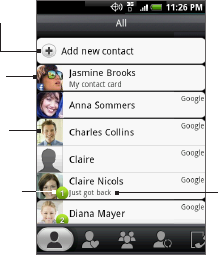
Using People 71
Create a new contact.
Tap to edit or update
My Contact Card
Tap any contact to open
the Contact Details
screen for that contact.
This icon appears when the
contact:
Has sent you a new text or
email message, or tried to call
you but you missed the call.
Has updated his or her
Facebook profile or has added
photos on Flickr or Facebook.
Has upcoming Facebook
events.
•
•
•
The Facebook
status appears
when you link
the contact to his
or her Facebook
account.
Note To view only contacts of a particular type, for example Gmail contacts
or Exchange ActiveSync contacts, press MENU, tap View, and select the
desired type of contact.

72 Using People
To add a new contact
1. On the All tab, tap Add contact.
2. Select the Contact type, for example Google or Exchange. This
determines which account the contact will sync with. For more
information, see “Contact sources” in this chapter.
3. Do one of the following:
For Exchange or Phone contact type, tap the Name field,
enter the first and last name of the contact, and choose the
order in which to display the names. Tap OK.
For Google contact type, tap the Name field and then enter
the name.
4. Enter the contact information in the fields provided.
5. Scroll to the bottom of the screen and tap Save.
To search for a contact
1. On the All tab, press MENU, and then tap Search people.
2. In the search bar, enter the first few letters of the first or last
name of the contact you are looking for. Matching contacts are
displayed.
Tip If the list of matching contacts is long, you can view more results by
tapping to hide the onscreen keyboard.
3. Tap the contact you want to open his or her Contact Details
screen. For information on what you can do on this screen, see
“The Contact Details screen” in this chapter.
To edit a contact’s information
1. On the All tab, press and hold the contact, and then tap Edit
contact.
2. Enter the new information for the contact.
3. Scroll to the bottom of the screen, and then tap Save.
•
•
Using People 73
To delete multiple contacts
1. On the All tab, press MENU and then tap Delete contacts.
2. Select the contacts you want to delete and tap Done.
3. When prompted, tap OK.
To delete one contact
On the All tab, press and hold the contact, and then tap Delete
contact.
To send contact information via MMS as a vCard
On the All tab, press and hold the contact you want to send, and
then tap Send contact as vCard. Enter the recipient and an optional
message, and then tap Send.
Note To send your own contact information (My contact card), on the All tab,
press and hold Me and then tap Send my contact card.
Using Favorites
On the Favorites tab, add the people you interact with most
frequently, so that you can always access them quickly.
To add a favorite contact
1. On the Favorites tab, tap Add favorite people, and then tap the
contact you want to add.
2. Choose a default communication method. When you have
added the People widget to the Home screen, you can tap a
favorite contact to get in touch with him or her directly using this
method. For more information, see “Adding the People widget”
earlier in this chapter.
Tip: To change the default communication method for a favorite contact,
press and hold the contact, and then tap Change default action.
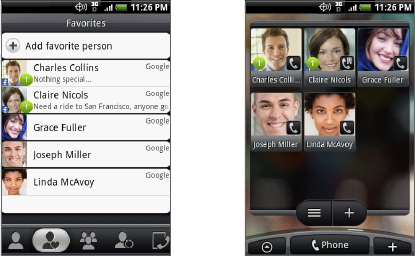
74 Using People
The contacts in your Favorites are the same as the contacts in the
People widget.
To remove a favorite contact
1. On the Favorites tab, press MENU, and then tap Remove favorite.
2. Tap the favorite contact you want to delete, and then tap Done.
3. When prompted, tap OK.
Working with Groups
On the Groups tab, you can assign contacts to groups so you can
easily send an SMS, MMS, or email message to a whole group. You
can also sync groups on your phone with the groups in your Google
account, accessible via your PC’s web browser.
To create a group and add contacts
1. On the Groups tab, tap Add new group.
2. Enter a name for the group.

Using People 75
3. Tap Add contact to group.
4. Select the contacts you want in the group, and then tap Done.
Tip If your contacts list is long, you can use the search bar to search
for contacts quickly, or tap to hide the onscreen keyboard and
scroll to the bottom of the contacts list.
5. Tap Save.
To delete a group
On the Groups tab, press and hold the group you want to delete, and
then tap Delete group.
To add or remove contacts from a group
1. On the Groups tab, press and hold the group, and then tap Edit
group.
2. To add contacts to the group, tap Add contact to group, select
the contacts you want to add, and then tap Done.
Tip If your contacts list is long, you can use the search bar to search
for contacts quickly, or tap to hide the onscreen keyboard and
scroll to the bottom of the contacts list.
3. To remove a contact from the group, tap (X) at the right side of
the contact name. Tap Save.
To sync groups on your phone with the groups in your Google
account
On the Groups tab, press MENU, tap Sync groups, select the groups
you want to sync and then tap Save.
To send an SMS/MMS message to all contacts in a group
On the Groups tab, press and hold the group, and then tap Send
group messages. For instructions on composing and sending your
message, see Chapter 5.
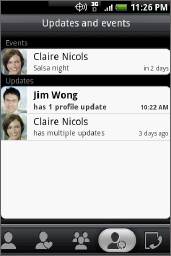
76 Using People
Note You will be charged by your service provider for each message sent.
For example, if you send a message to a group of five people, you will
be charged for five messages.
To send an email message to all contacts in a group
On the Groups tab, press and hold the group, and then tap Send
group mail. For instructions on composing and sending your message,
see Chapter 5.
3.3 Using Facebook and Flickr in People
If your contacts have Facebook accounts, you can view their current
status and upcoming events, and be notified when they change their
profile information. You can also update your own Facebook status. In
addition, if your contacts have Flickr accounts, you can see when they
add new photos.
Facebook and Flickr notifications are shown on the following tabs:
On the Updates and events
tab of the people screen,
notifications of contacts’
upcoming events and
updates to their profiles are
displayed. Tap a notification
to go to the Updates and
events tab of the Contact
Details screen for the
relevant contact.
•

Using People 77
On the Updates and events
tab of the Contact Details
screen for each contact,
the contact’s Facebook
status, profile updates,
and upcoming events are
displayed. Notifications of
new photo uploads to Flickr
are also displayed. Tap an
item to open the browser
and go to the relevant
webpage in Facebook or
Flickr.
•
On the Albums tab of the
Contact Details screen for
each contact, the contact’s
recent Facebook and Flickr
photo albums are displayed.
Tap an album to view the
photos in the Albums
program. For information
on what you can do in the
Albums program, see
Chapter 7.
•

78 Using People
To log in to Facebook or Flickr
1. On the All tab of the People screen, tap Me, press MENU, and
then tap Edit.
Note If you have not entered your contact details on My contact card,
you can do so now. For information, see “Setting up My contact
card” in this chapter.
2. Scroll down and tap Facebook or Flickr.
3. Enter your login details and then tap Log in.
To log out of Facebook or Flickr
1. On the All tab of the People screen, tap [Name] My contact card,
press MENU, and then tap Edit.
2. Tap ( ) to hide the onscreen keyboard, and then tap
Facebook or Flickr.
3. When prompted, tap OK, and then tap Save.
To update your Facebook status
On the All tab of the People screen, tap [Name] My contact card, and
then tap Facebook. Enter your status, and then tap Share.
To link to your contacts’ Facebook accounts
1. On the People screen, slide to the Updates and events tab.
2. If you did not link to Facebook on My contact card, tap Link to
Facebook and enter your Facebook login information.
3. Tap Link profiles.
Note The Link profiles button may take a while to appear.
4. On the Select matching friends screen, select which contacts’
Facebook accounts you want to link to, and then tap Next.

Using People 79
Note If you later want to link a contact who did not appear in the list,
open his or her Contact Details screen, slide to the Updates and
events tab, and tap Link Facebook profile. For more information,
see “Using the Contact Details screen” in this chapter.
5. On the Link profile message box, select from the following
options:
Use photo. Use your matched Facebook friends’ profile
pictures as their contact ID pictures on your phone.
Use birthday. Store your matched Facebook friends’ birthdays
in their contact details on your phone.
To change Facebook and Flickr update settings
On the People screen, slide to the Updates and events tab, press
MENU, and then tap Data connection settings.
3.4 Using the Contact Details screen
When you tap a contact on the People screen, the Contact Details
screen opens, showing you the information stored for that contact,
exchanged messages and phone calls with that contact, Facebook
notifications, and more.
The Contact Details screen has the following tabs:
Information
Messages
Email
Updates
and events
Albums
Call history
•
•

80 Using People
Tab Functions
Information Shows the information you have stored for the contact,
and allows you to get in touch with the contact directly
by tapping any of the displayed methods. For example,
if the contact has a stored work phone number, tap Call
Work to call that number.
You can also add one of the contact’s phone numbers
as a speed dial number. For information, see “To add a
contact to speed dial” in this chapter.
Messages Shows your exchanged SMS messages with the
contact. Tap a message to view it. To send a new
message, press MENU and tap Send message. For
more information about messages, see. Chapter 5.
Email Shows email messages you have received from the
contact. Tap an email message to view it. To send a
new email message, press MENU and tap New mail. For
more information about email, see Chapter 5.
Updates and
events
Shows the contact’s Facebook status, updates, and
events, and shows when he or she uploads new photos
to Flickr.
When there is a notification of the contact’s birthday,
you can tap the notification to call the contact directly
or send a message greeting.
Albums Shows the contact’s Facebook and Flickr photo
albums. For more information, see “Using Facebook
and Flickr in People” in this chapter.
Call history Lists all your incoming, outgoing, and missed calls to
and from the contact. Tap a list item to call the contact
using the displayed number.
Using People 81
To add a contact to speed dial
1. On the Information tab of the Contact Details screen, press
MENU and then tap Set speed dial.
2. In Number, tap Not defined, and then tap the contact number
you want to assign to the speed dial number.
3. In Location, tap Not defined, and then tap a speed dial key
(number 2 to 9). When you press and hold the assigned key on
the phone dialer screen, your phone will call the contact. For
more information about making calls using the phone dialer
screen, see “Calling using the phone dialer screen” in Chapter 2.
4. Tap Save.
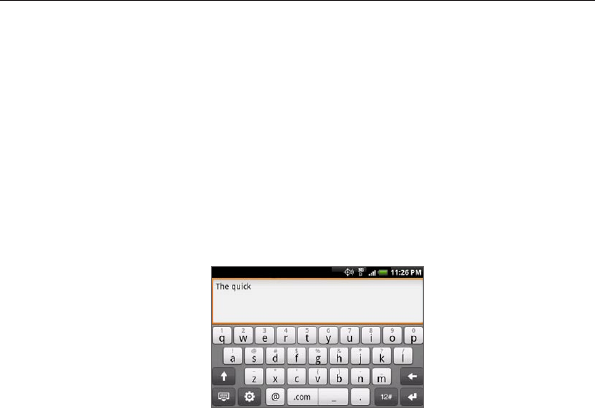
4.1 Using the Onscreen Keyboard
When you start a program or select a field that requires text or
numbers, the onscreen keyboard becomes available. You can choose
from these keyboard layouts: QWERTY, Compact QWERTY, and
Phone keypad.
Using the landscape onscreen keyboard
When entering text, you can choose to use the landscape orientation
of the onscreen keyboard, by turning the phone sideways, to use a
larger keyboard that lets you type easily using two thumbs.
Notes • The Orientation check box in HOME > MENU > Settings > Sound
& display needs to be selected for the screen orientation to
automatically change.
• The landscape orientation keyboard is not supported in all
applications.
Chapter 4
Entering Text
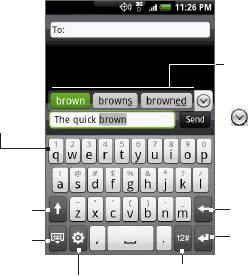
Entering Text 83
QWERTY
QWERTY is a keyboard layout similar to a desktop computer
keyboard.
Displays the word
candidate list when
word prediction
is turned on. Tap
a word to insert it
into your text. Tap
to see more
candidate words.
• Tap to enter
letters or
symbols.
• Press and hold to
enter accented
letters, numbers,
or symbols.
• Tap to enter an
uppercase letter.
• Tap twice to turn
on Caps Lock.
Tap to switch to the numeric
and symbol keyboard. See
“Entering Numbers and
Symbols” for details.
Tap to create a
new line.
Tap to delete
the previous
character.
Tap to hide
the keyboard.
Tap to open a menu where
you can change the keyboard
layout and open the Touch Input
Settings.
See “Adjusting Text Input and
Keyboard Settings” for details.
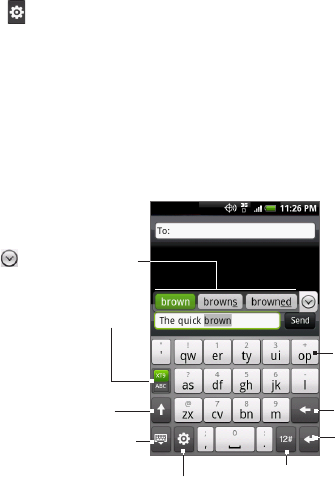
84 Entering Text
To enter text using QWERTY
1. Start a program that accepts text input
2. Tap , and then tap Keyboard types > QWERTY.
3. Start tapping keys on the onscreen keyboard as you would on a
PC keyboard to enter your text.
Compact QWERTY
Compact QWERTY is a type of keyboard which features 20 keys.
With its large, touch-friendly keys and enhanced features such as XT9
predictive input, you can enter text faster and more accurately.
Tap to toggle between
using Multitap or XT9
mode.
Displays the word
candidate list in XT9
mode. Tap a word to
insert it into your text.
Tap to see more
candidate words.
• Tap to enter
letters or symbols.
• Press and
hold to enter
a punctuation
mark, symbol,
or number that
appears on top of
a key.
• Tap to enter an
uppercase letter.
• Tap twice to turn
on Caps Lock.
Tap to switch to the numeric
and symbol keyboard. See
“Entering Numbers and
Symbols” for details.
Tap to create a new
line.
Tap to delete the
previous character.
Tap to hide
the keyboard.
Tap to open a menu where you can
change the keyboard layout and open
the Touch Input Settings.
See “Adjusting Text Input and
Keyboard Settings” for details.
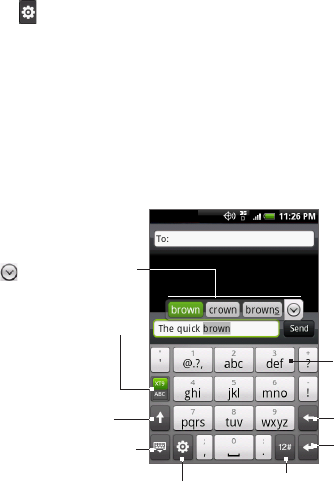
Entering Text 85
To enter text using Compact QWERTY
1. Start a program that accepts text input.
2. Tap , and then tap Keyboard types > Compact QWERTY.
3. Start tapping keys on the onscreen keyboard to enter your text.
Phone keypad
Phone keypad is a 12-key onscreen keypad that has a layout similar to
mobile phone keypads, plus some additional keys. The Phone keypad
has large keys and enhanced input features such as XT9 predictive
input, which makes it faster for you to enter text in your messages and
documents.
Tap to toggle between
using Multitap or XT9
mode.
Displays the word
candidate list in XT9
mode. Tap a word to
insert it into your text.
Tap to see more
candidate words.
• Tap to enter
letters or symbols.
• Press and
hold to enter
a punctuation
mark, symbol,
or number that
appears on top of
a key.
• Tap to enter an
uppercase letter.
• Tap twice to turn
on Caps Lock.
Tap to switch to the numeric
and symbol keyboard. See
“Entering Numbers and
Symbols” for details.
Tap to create a new
line.
Tap to delete the
previous character.
Tap to hide the
keyboard.
Tap to open a menu where you can
change the keyboard layout and open
the Touch Input Settings.
See “Adjusting Text Input and Keyboard
Settings” for details.
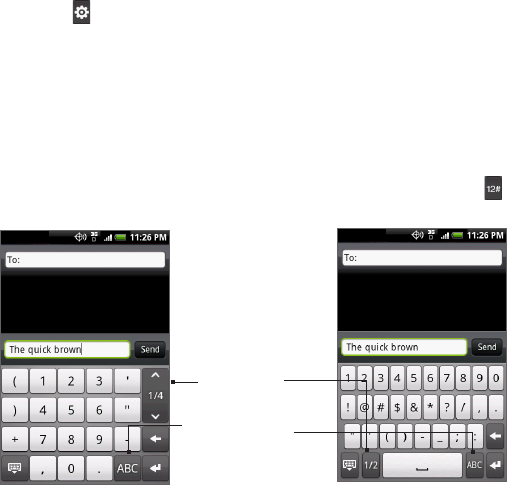
86 Entering Text
To enter text using Phone keypad
1. Start a program that accepts text input.
2. Tap , and then tap Keyboard types > Phone keypad.
3. Start tapping keys on the onscreen keyboard to enter your text.
4.2 Entering Numbers and Symbols
Switch to the numeric and symbol onscreen keyboard to let you easily
enter numbers and common symbols such as parentheses, braces,
currency signs, punctuation marks, special characters, and more.
To switch to the numeric and symbol onscreen keyboard, tap on
the alphanumeric keyboard.
Tap to switch
back to the
alphanumeric
keyboard.
Compact QWERTY and
Phone keypad.
QWERTY keyboard
Tap to
show more
symbols.

Entering Text 87
4.3 Adjusting Touch Input Settings
Open the Touch Input settings by doing one of the following:
On any of the keyboard layouts, tap to open the Touch Input
settings.
On the Home screen, press MENU and then tap Settings > Locale
& text > Touch Input.
Touch Input settings
Keyboard types Tap to select the keyboard layout to use. You
can choose from QWERTY, Phone Keypad, or Compact QWERTY.
Keyboard language Tap to select the language layout of the
keyboard.
Text input Tap to set text input options when entering text,
calibrate the keyboard, and set a sound and/or vibration
feedback whenever you tap a key. See “Text input” for details.
Tutorial Tap to learn how to use the onscreen keyboard.
Text input
QWERTY
Prediction Select to enable the word prediction feature which
provides a list of possible words that reflect the characters of
the keys you have tapped as well as characters of nearby keys.
Spell correction Select to correct typographical errors
by selecting from a list of possible words that reflect the
characters of the keys you have tapped as well as characters
of nearby keys.
•
•
•
•
•
•
•
•
•
88 Entering Text
Phone keypad & Compact QWERTY
Spell correction Select to correct typographical errors
by selecting from a list of possible words that reflect the
characters of the keys you have tapped as well as characters
of nearby keys.
Word completion When using the Compact QWERTY
or Phone keypad, lets you select from a list of possible
combinations based on the characters that appear on the keys
that you tapped.
Other settings
Sound feedback Select to make a clicking sound whenever
you tap a key on the keyboard.
Vibrate when typing Select to enable vibration feedback
whenever you tap a key on the keyboard.
Finger touch precision
Calibration tool Tap to re-calibrate the keyboard touch
accuracy. Re-calibrate the keyboard if you feel that the
keyboard keys are not responding accurately to your taps.
Reset calibration Tap to reset the calibration back to factory
default.
•
•
•
•
•
•
•
•
•
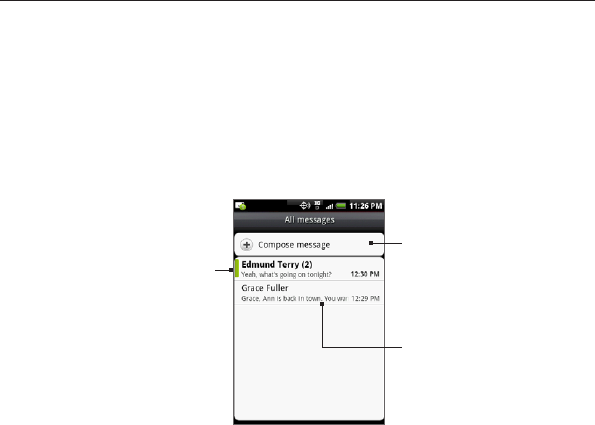
5.1 Sending Text and Multimedia Messages
Messages lets you compose and send text (SMS) and multimedia
messages (MMS) to other mobile phones.
Opening Messages
Press HOME, then tap Messages.
Tap to create a
new text or picture
message.
Tap to open the
message or message
thread and read
the text or view the
picture message.
If the list of messages
does not fit on the
screen, you can scroll
up the screen to view
more messages, or
roll the TRACKBALL
down.
Indicates new
messages in
the thread.
Chapter 5
Exchanging Messages
90 Exchanging Messages
Creating and sending SMS and MMS messages
Send short text messages (SMS) to other mobile phones. If you
exceed the limit on the number of characters for a single text
message, your text message will be delivered as one but will be billed
as more than one message.
Multimedia messages, also known as MMS, can contain text and a
picture, a recorded voice, an audio or video file, a picture slideshow,
contact card (vCard), or appointment (vCalendar).
Note The Messages application automatically converts a text message into a
multimedia message when you entered an email address in the To field,
added a message subject, or attached an item.
To create and send a text message
1. On the All messages screen, tap Compose message. The
Compose screen opens.
2. In the To field, enter the recipient’s mobile phone number. You
can also enter the first few letters of the recipient’s name to
display a matching list of names from your stored contacts, and
then tap a recipient to automatically fill in the person’s phone
number.
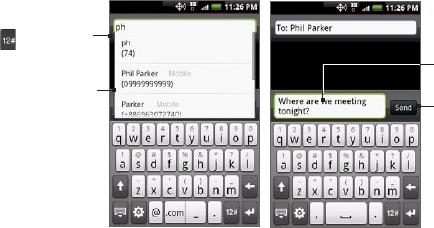
Exchanging Messages 91
Enter a name to
look up a contact
or tap to enter a
phone number.
Enter
your text
message
here.
Tap to automatically
enter the mobile
phone number of the
matched contact.
Note: The phone
number only appears
if the number was
filed under Mobile in
Contacts.
Tap to send
the message.
3. Tap the text box that contains the text “Tap to compose”, and
then start composing your message.
Note As you near character limit for a single message, a counter will
appear in the top right corner of the text box to tell you how many
characters are left. Once you go over that limit, a new message is
created but automatically joined into one when received.
4. When done, tap Send to send the text message.
Note To receive delivery reports and know when a text message is received, in
the All messages screen, press MENU and then tap Settings. In the SMS
settings section, select the Delivery reports check box.
To create and send a multimedia (MMS) message
1. On the All messages screen, tap Compose message. The
Compose screen opens.
2. In the To field, enter the recipient’s mobile phone number or
email address. You can also enter the first few letters of the
recipient’s name to display a matching list of names from your
stored contacts, and then tap a recipient to automatically fill in
the person’s phone number or email address.
92 Exchanging Messages
Tip You can add a subject line by pressing MENU and then tapping Add
subject.
3. Tap the text box that contains the text “Tap to compose”, and
then start composing your message.
4. Press MENU and then tap Attach.
5. On the Attach window, select from the following file attachments:
Picture. Opens the Albums application. Select a picture to attach
it to your message.
Video. Opens the Albums application. Select a video to attach it
to your message.
Audio. Opens the Select music track screen. Tap an audio file to
select, and then tap OK to attach the file into your message. The
music file plays back when you tap it.
Location. Lets you attach a Footprint or location on a map. See
Chapter 9 for details about Footprints.
Contact (vCard). Lets you attach contact details of a contact in
your phone.
Appointment (vCalendar). Lets you attach an appointment from
Calendar.
Create. Lets you take a picture, record a video or audio, or create
a slideshow and then attach it to your message.
Camera. Opens the Camera application. Take a picture of
your subject, and then tap Done to attach it to your message.
For more information about the Camera application, refer to
“Using Camera and Camcorder” in Chapter 7.
Record video. Opens the Camcorder application. Shoot a
video, and then tap Done to attach it to your message. For
more information about the Camcorder application, refer to
“Shoot videos” in Chapter 7.
•
•
•
•
•
•
•
•
•
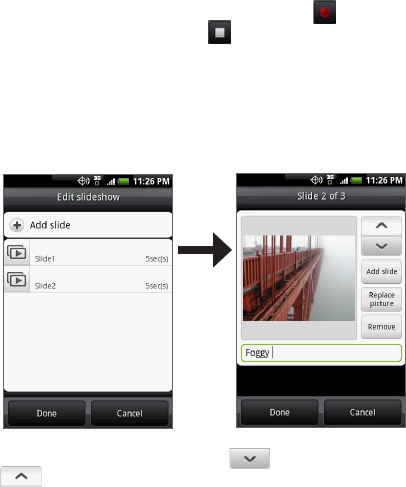
Exchanging Messages 93
Record audio. Opens Voice Recorder. Tap to start recording
your message, and then tap to stop.
Slideshow. Opens the Edit slideshow screen. Tap Add slide to
create a new slide. Tap the created slide (for example, Slide 1),
tap Insert picture, and then select the picture you want to add
to the slide. You can also navigate to the text box and enter a
caption for the picture. When finished, tap Done to attach the
slideshow to your message.
Tips • When editing multiple slides, tap to edit the next slide or tap
to return to the previous slide.
• While editing the slideshow, press MENU to let you preview the
slideshow, add music or video to a slide, remove a slide, and more.
6. When you are finished composing the multimedia message,
tap Send.
•
•
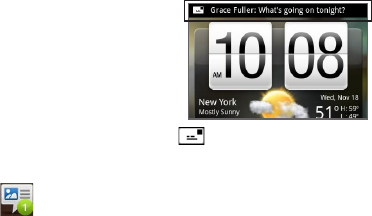
94 Exchanging Messages
Note To receive delivery reports and know when a picture message is
received, in the All messages screen, press MENU, and then tap Settings.
Select the Delivery reports check box below the MMS settings section.
To save a message as a draft
While composing a text or multimedia message, press BACK to
automatically save your message as a draft. To resume composing
the message, tap the message in the All messages screen. Continue
editing the message, and then tap Send to send it.
Receiving text and multimedia messages
Depending on your notification settings, the phone will play a ring
tone, vibrate, or display the message briefly in the status bar when you
receive a new text or multimedia message. To change the notification
for new text and multimedia messages, see “Setting text and
multimedia message options” later in this chapter.
A new message icon ( ) also appears in the notifications area of
the status bar to notify you of a new text or multimedia message. The
Messages application icon also displays the number of new messages
. To open the message, refer to the next section.
Exchanging Messages 95
Managing messages and message threads
Text and multimedia messages that are sent to and received from a
contact (or a number) are grouped into conversations or message
threads in the All messages screen. Threaded text or multimedia
messages let you see exchanged messages (similar to a chat program)
with a contact on the screen. Message threads are listed in order of
when you received them, with the latest message on top of the thread.
To open and read a text message
Do one of the following:
Press HOME, then press and hold the status bar, and then slide it
down to open the Notifications panel. Tap the new message to
open and read it.
On the All messages screen, tap the text message or message
thread to open and read it.
To return to the All messages screen from a text message thread,
press MENU and then tap All messages.
Notes • To view the details of a particular message, in the message thread,
press and hold the message to open the options menu, and then tap
View message details.
• If a message contains a link to a web page, tap the link to let you
open the link in Browser or add the URL as a bookmark.
• If a message contains a phone number, tap the message to open the
phone dialer screen so you can call the number.
To open and view a multimedia message
1. On the All messages screen, tap a multimedia message or
message thread to open it.
2. Tap the Play button at the right side of a multimedia message to
view it.
•
•
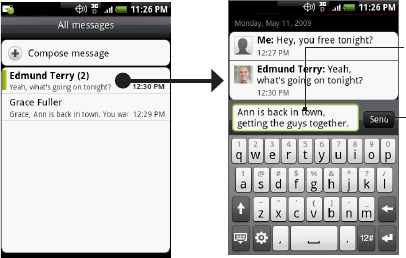
96 Exchanging Messages
Tip You can save the file attachment on the multimedia message to the
SD card. To save, press and hold the file and then tap Copy attached
to SD card on the options menu.
Notes • When Auto-retrieve in MMS settings is disabled, only the message
header is downloaded. To download the entire message, tap the
Download button at the right side of the message. Once the message
has downloaded, tap the Play button to view the message. For
details, see “Setting text and multimedia message options” later in
this chapter.
• If you are concerned about the size of your data downloads, check
the multimedia message size before you download it.
To reply to a text or multimedia message
1. On the All messages screen, tap a text or multimedia message
thread to open it.
2. Tap the text box at bottom of the screen, enter your reply
message, and then tap Send.
Enter
your reply
message
here.
Tap to send
your reply.
Tap to open
the message.

Exchanging Messages 97
Tip To reply a text message with a multimedia message, open the text
message, press MENU and then tap Add subject, or Attach. The text
message is automatically converted into a multimedia message.
To delete a message or a message thread
1. On the All messages screen, tap the message thread that you
want to delete.
2. Do one of the following:
To delete the entire thread, press MENU and then tap Delete.
When prompted to confirm, tap OK.
To delete a message in a thread, press and hold the message
that you want to delete, and then tap Delete message on the
options menu. When prompted to confirm, tap OK.
Note To delete several messages on the All messages screen, press MENU
while on the All messages screen, tap Delete, select the messages you
want to delete, and then tap Delete.
Setting text and multimedia message options
On the All messages screen, press MENU and then tap Settings to set
the text or multimedia message options. You can set the following:
SMS settings
Delivery
reports
Select this option to receive a report on the delivery status
of your message.
Service Center Displays the message service center number used. Tap to
change the number. It is recommended that you do not
change the number here for it may cause problems in
receiving and sending messages.
•
•

98 Exchanging Messages
MMS settings
Auto-retrieve Select this option to automatically retrieve all your MMS
messages completely. When selected, the MMS message
header plus the message body and attachments will
automatically download to your phone. If you clear this
check box, only the MMS message header will be retrieved
and shown in your All messages screen.
Roaming auto-
retrieve
Select this option to automatically retrieve all your MMS
messages completely when roaming. This may incur
significant phone charges.
Priority setting Set the message priority of MMS messages sent.
Maximum
message size
Set the maximum file size of an MMS message. The MMS
message will not be sent out if it exceeds the file size set
here.
Connection
settings
Set MMS connection settings.
Notification settings
Notifications Select this option if you want to receive a notification in the
status bar when a new text or multimedia message arrives.
Select sound If you want the phone to ring when a new message arrives,
tap this option, and then select a ring tone that is specific
to new text and multimedia messages. Note that the ring
tone briefly plays when selected.
Vibrate Select this option if you want the phone to vibrate when a
new text or multimedia message arrives.
Adding the Messages widget
Add the Messages widget to let you read your messages on the Home
screen. To learn how to add widgets, refer to “To add an HTC widget”
in Chapter 1.
Exchanging Messages 99
5.2 Using Mail
The Mail application lets you add external POP3 or IMAP email
accounts from popular web-based email service providers such as
Hotmail® and AOL®. It also lets you add an Exchange ActiveSync
account on your phone.
Adding a POP3/IMAP email account
1. Press HOME, then tap Mail.
2. On the Choose a mail provider screen, tap Other (POP3/IMAP).
Note If the account type you want to set up is not in the phone database,
you will be asked to enter more details. It is recommended that
you get all pertinent information for the email account such as
incoming/outgoing server settings before you proceed.
3. Enter the Email address and Password for the email account and
then tap Next.
4. Enter the Account name and Your name and then tap Finish
setup.
Adding a Microsoft Exchange ActiveSync account
You can only add one Microsoft Exchange ActiveSync account on
your phone.
Requirement You can sync with a Microsoft Exchange Server 2003 Service
Pack 2 (SP2) or Microsoft Exchange Server 2007.
1. Press HOME, then tap Mail.
2. On the Choose a mail provider screen, tap Microsoft Exchange
ActiveSync.
3. Enter the Exchange ActiveSync account details and then tap
Next.
100 Exchanging Messages
Note Your corporate Exchange Server must support auto-detect for the
phone to automatically set up the Exchange ActiveSync account. If
your corporate Exchange Server does not support auto-detect, you
will need to enter your Exchange Server settings after you tap Next.
Ask your Exchange Server administrator for details.
4. Select the type of information you want to synchronize and then
tap Finish setup.
Synchronizing Exchange ActiveSync emails
You can set Exchange ActiveSync to automatically check for new
Exchange ActiveSync emails.
1. Press HOME > MENU, and then tap Settings > Data
synchronization > Exchange ActiveSync.
2. Tap Schedule and then tap the time interval you want to use to
check for new emails.
Tip On the Exchange ActiveSync screen, tap Sync now at the bottom of the
screen to manually check for new emails.
Changing Exchange ActiveSync settings
1. Press HOME > MENU, and then tap Settings > Data
synchronization > Exchange ActiveSync.
2. Press MENU and then tap Settings.
3. Change the general settings and mail and calendar settings
according to your preference.
4. Press BACK after you are done.
Creating another email account
Do one of the following:
If you are in the Accounts list screen, press MENU, and then tap
New account
•
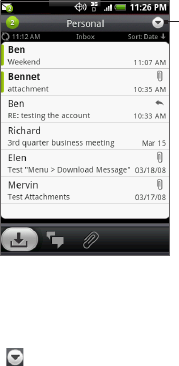
Exchanging Messages 101
If you are in the Inbox of an email account, press MENU and then
tap More > New account.
To switch to another
account, in an email
account inbox, tap the
arrow and then select
the email account to
use.
Composing and sending emails
1. Press HOME, then tap Mail.
2. On the email account Inbox, press MENU and then tap Compose.
Tip Tap on the upper-right corner to switch to a different email
account.
3. Enter the message recipient’s email address in the To field.
As you enter information, matching contacts will appear on the
screen. Tap the recipient or continue entering the email address.
If you are sending the email to several recipients, separate the
email addresses with a comma. You can add as many message
recipients as you want.
Tips • If you want to send a carbon copy (Cc) or a blind carbon copy (Bcc)
of the email to other recipients, press MENU and then tap Add
recipient > Cc or Bcc.
•

102 Exchanging Messages
• If you have set up an Exchange ActiveSync account, press MENU
and then tap Add recipient > To > Company directory to let you add
recipients from the Exchange ActiveSync account contacts.
4. Enter the subject, and then compose your message. Tap Send.
Note Tap Save as draft to save the message as a draft.
Viewing and replying to emails
1. Press HOME, then tap Mail.
2. On the email account Inbox, tap the email you want to view.
Tip Tap on the upper-right corner to switch to a different email
account.
3. Tap Reply or Reply all to reply to the email.
For an Exchange ActiveSync account, you can mark an email. To
mark an email, while viewing an email, tap the white flag ( ) on the
upper-right corner of the screen. The flag turns red ( ) when you
mark the message.
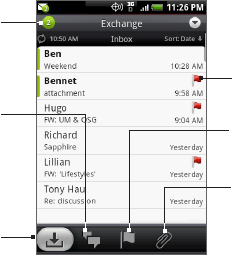
Exchanging Messages 103
Managing emails on your external email account
To filter the inbox
Tap a tab at the bottom of the screen to filter the inbox by individual
emails, conversations, or emails with attachments.
Conversations
Displays emails as
conversations. Email
correspondence are
grouped according to
the subject line. Tap an
email to show the emails
in a conversation.
Marked (Exchange
ActiveSync only)
Displays all flagged
emails.
Inbox
Displays emails as
individual items.
Attachments
Displays all emails that
have attachments.
Number of
unread emails.
Marked (Exchange
ActiveSync only)
email
To sort messages
1. On the email account Inbox, press MENU, and then tap Sort.
2. Select from the following sort options:
Date (Most recent/Oldest) Sorts email messages by the time
you received it.
Subject (A-Z/Z-A) Alphabetically sort email messages by
subject.
Sender (A-Z/Z-A) Alphabetically sort email messages by
sender.
Size (Largest/Smallest) Sort emails by file size.
•
•
•
•

104 Exchanging Messages
To delete a message
1. On the email account Inbox, press and hold the email you want to
delete.
2. On the options menu, tap Delete. When prompted to confirm
deletion, tap OK.
To delete multiple messages
1. On the email account Inbox, press MENU and then tap Delete.
2. Tap the emails you want to delete, and then tap Delete.
Editing email account settings
1. Press HOME, then tap Mail.
2. Switch to the email account you want to edit.
3. Press MENU and then tap More > Settings.
Account settings Change the email account settings such as the name,
email address, password, and description.
General settings Set the font size when reading emails, enable,
disable or set the signature, set the account as the
default email account, and set where to save email
attachments.
Send & receive Set the maximum email file size limit when receiving
and frequency to check for new emails and how
many to check for. You can also set to have emails
that you send bcc’d to yourself.
Notification
settings
Set email notification settings.
Delete account Tap to delete the email account.
4. Press BACK to save your changes.
Exchanging Messages 105
Sending a meeting request using the Exchange
ActiveSync account
1. Press HOME, then tap Mail.
2. Switch to the Exchange ActiveSync account.
3. Press MENU and then tap More > New meeting invitation.
4. Enter the meeting details and then tap Send.
Deleting an email account
1. Press HOME, then tap Mail.
2. Switch to the email account you want to delete.
3. Press MENU and then tap More > Settings > Delete account.
Adding the Mail widget
Add the Mail widget to let you view your POP3/IMAP or Exchange
ActiveSync emails on the Home screen. To learn how to add widgets,
refer to “To add an HTC widget” in Chapter 1.

6.1 Connecting to the Internet
Your phone’s networking capabilities allow you to access the Internet
through data connection or Wi-Fi.
6.2 Data Connection
Settings for connecting to the data network are already preconfigured
on your device, and your device is ready to connect to the Internet
6.3 Wi-Fi
Wi-Fi provides wireless Internet access over distances of up to 300
feet (100 meters). To use Wi-Fi on your phone, you need access to a
wireless access point or “hotspot”.
Note The availability and range of the Wi-Fi signal depends on the number,
infrastructure, and other objects through which the signal passes.
Chapter 6
Getting Connected

Getting Connected 107
Turning Wi-Fi on and connecting to a wireless network
1. Press HOME > MENU, and then tap Settings > Wireless controls.
2. Select the Wi-Fi check box to turn Wi-Fi on. The phone will scan
for available wireless networks.
3. Tap Wi-Fi settings. The network names and security settings
(Open network or Secured with WEP) of detected Wi-Fi
networks are displayed in the Wi-Fi networks section.
4. Tap a Wi-Fi network to connect. If you selected an open network,
you will be automatically connected to the network. If you
selected a network that is secured with WEP, enter the key and
then tap Connect.
Notes • The next time your phone connects to a previously accessed secured
wireless network, you will not be prompted to enter the WEP key
again, unless you reset your phone to its factory default settings.
• Wi-Fi networks are self-discoverable, which means no additional steps
are required for your phone to connect to a Wi-Fi network. It may be
necessary to provide a username and password for certain closed
wireless networks.
Checking the wireless network status
You can check the current wireless connection status from the
following:
Status bar
When your phone is connected to a wireless network, the
Wi-Fi icon ( ) appears in the status bar and tells you the
approximate signal strength (number of bands that light up).
If Network notification in Wi-Fi settings is enabled, this icon
appears in the status bar whenever the phone detects an
available wireless network within range.
•
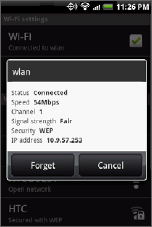
108 Getting Connected
Wi-Fi networks
On the Wireless controls screen, tap
Wi-Fi settings, then tap the wireless
network that the phone is currently
connected to.
A message box will be displayed
showing the Wi-Fi network name,
status, speed, signal strength, and
more.
Note If you want to remove the wireless
network settings on your phone, tap
Forget on this window. You need to
enter the settings again if you want to
connect to this wireless network.
To connect to another Wi-Fi network
1. On the Wireless controls screen, tap Wi-Fi settings. Detected Wi-
Fi networks are displayed in the Wi-Fi networks section.
Tip To manually scan for available Wi-Fi networks, on the Wi-Fi settings
screen, press MENU and then tap Scan.
2. Tap another Wi-Fi network to connect to it.
Note If the wireless network you want to connect to is not in the list of
detected networks, scroll down the screen, then tap Add a Wi-Fi
network. Enter the wireless network settings, then tap Save.
•
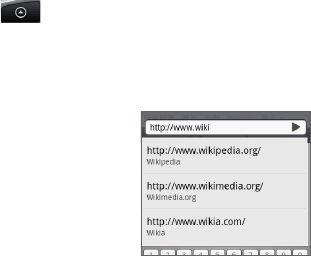
Getting Connected 109
6.4 Using Browser
Open Browser to start surfing the web. Browser is fully optimized and
comes with advanced features that let you enjoy Internet browsing on
your phone.
Note You must have an active data or Wi-Fi connection to access the Internet.
Opening Browser
Do one of the following:
Press HOME, then tap Browser.
Press HOME, then tap > Browser.
Going to a web page
1. On the Browser screen, press MENU and then tap the URL field
on top of the screen.
2. Enter the web page address
using the keyboard. As you
enter the address, matching web
page addresses will appear on
the screen. Tap an address to
go directly to that web page or
continue entering the web page
address.
3. Tap Go.
Setting your home page
1. Press MENU and then tap More > Settings > Set home page.
2. In the Set home page screen, select the home page you want to
use.
•
•
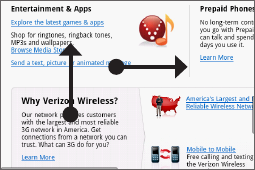
110 Getting Connected
Changing the screen orientation
The phone automatically changes the screen orientation depending
on how you are holding your phone.
Note The Orientation check box in HOME > MENU > Settings > Sound &
display needs to be selected for the screen orientation to automatically
change.
Browsing classic views (not mobile version) of web
pages
On a browser screen, press MENU, then tap More > Settings, and then
clear the Mobile view check box.
Navigating on a web page
You can roll the TRACKBALL or slide your finger on the screen in any
direction to navigate and view other areas of the web page.
Slide your
finger left or
right to scroll
horizontally.
Slide your
finger up or
down to scroll
vertically.
Zooming in or out on a web page
Tap the screen twice quickly to zoom in, then tap the screen twice
quickly again to zoom out. You can also use your fingers to pinch or
spread the screen to zoom in and out.
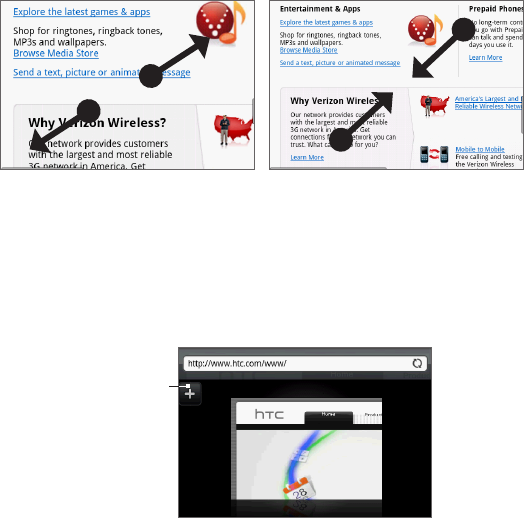
Getting Connected 111
Use your thumb and index fingers to
‘spread’ the web page to zoom in.
Use your thumb and index fingers to
‘pinch’ the web page to zoom out.
Opening a new browser window
Open multiple browser windows to make it easier for you to switch
from one web site to another. You can open up to 4 browser windows.
1. On a browser window, press MENU and then tap Windows.
2. Tap the “+” button.
Tap to open a
new browser
window.
A new browser window opens and goes to the home page that is set.
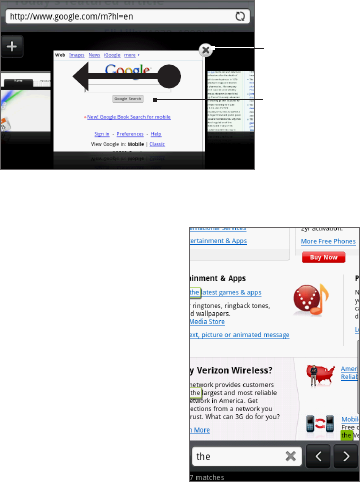
112 Getting Connected
Switching between browser windows
1. On a browser window, press MENU and then tap Windows.
2. Select the browser window you want to view by sliding your
finger on the screen from right to left.
Tap to
close the
web page.
Tap to
display the
web page in
full screen.
Finding text within a web page
1. While viewing a web page,
press MENU and then tap More
> Find on page.
2. Enter the search item. As you
enter characters, matching
characters will be highlighted
in green. Tap the left or right
arrow to go to the previous or
next matching item.
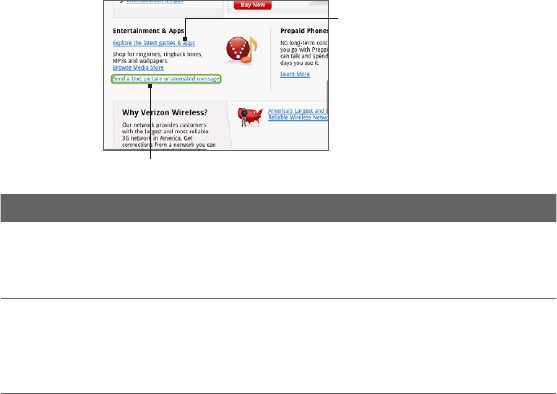
Getting Connected 113
Selecting links in web pages
Navigate to links on a web page using the TRACKBALL. Links are
enclosed in a colored box when selected.
Link is selected
Link is not
selected
Link What to do
Web page
address (URLs)
Tap the link to open the web page.
Press and hold the link to open a menu that allows you to
open, bookmark, copy to the clipboard, or share the link
via email.
•
•
Email address Tap to send an email message to the email address.
Press and hold, then tap Copy on the menu to copy the
email address to the clipboard. You can paste the email
address later when creating a new contact or sending a
new email message.
•
•
Browser also recognizes some phone numbers and addresses that
allow you to call the phone number or locate the address in Google
Maps™. Recognized phone numbers and addresses are highlighted in
green when navigated to.

114 Getting Connected
Link What to do
Location
address
Tap the address to open Google Maps and locate the
address.
Phone number Tap to open the phone dialer screen to call the phone
number.
Tip When links are too small for tapping directly on the screen, highlight it
with the TRACKBALL, then either press the TRACKBALL to open the
link, or press and hold the TRACKBALL to select an option from the
menu.
Downloading web applications
Before you can download web applications, you must first enable
downloading from the phone settings.
Press HOME > MENU, and then tap Settings > Applications.
Select the Unknown sources check box.
When the Attention dialog box opens, tap OK.
Note All downloaded applications are saved to the storage card.
Before you download an application from the web, make sure that
the storage card is in your phone. For information on how to install
a storage card, refer to Chapter 1.
Warning! Applications downloaded from the web can be from unknown
sources. To protect your phone and personal data, download
applications only from trusted sources such as Android Market.
Refer to “Android Market” in Chapter 8 for details.
To view your downloads
On a browser screen, press MENU and then tap More > Downloads.
1.
2.
3.
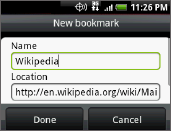
Getting Connected 115
Managing bookmarks
You can store as many bookmarks as you want on your phone.
To bookmark a web page
On a browser screen, go to the web
page you want to book mark.
Press MENU and then tap New
bookmark. The New bookmark screen
opens.
Edit the bookmark Name if needed and
then tap Done.
1.
2.
3.
To open a bookmark
On the Browser screen, press MENU and then tap Bookmarks.
Select the bookmark you want to open by sliding your finger
from right to left.
Once the bookmark you want to open is selected, tap it to open
it.
By default, a snapshot of the bookmarked web page is shown, letting
you visually select the bookmark. You can toggle between using
visual bookmarks or a list by pressing MENU and then tapping List or
Thumbnails.
To edit a bookmark
On the Browser screen, press MENU and then tap Bookmarks.
Press MENU and then tap Edit.
Select the bookmark you want to edit by sliding your finger from
right to left.
Once the bookmark you want to edit is selected, tap it.
Enter your changes and tap Done.
1.
2.
3.
1.
2.
3.
4.
5.
116 Getting Connected
If you are using the List view, press and hold the bookmark you want
to edit, and then tap Edit bookmark to edit the bookmark.
Setting Browser options
Customize Browser to suit your browsing lifestyle. Set display, privacy,
and security options when using Browser.
On the Browser screen, press MENU, and then tap More > Settings.
6.5 Using Bluetooth
Bluetooth is a short-range wireless communications technology that
allows Bluetooth devices to exchange information over a distance of
about 26 feet (8 meters) without requiring a physical connection.
Bluetooth on your phone operates in three different modes:
On. Bluetooth is turned on. Your phone can detect other
Bluetooth-enabled devices, but not vice versa.
Discoverable. Bluetooth is turned on, and all other Bluetooth-
enabled devices can detect your phone.
Off. Bluetooth is turned off. In this mode, you can neither send
nor receive information using Bluetooth.
Notes • By default, Bluetooth is turned off. If you turn it on, then turn off your
phone, Bluetooth also turns off. When you turn on your phone again,
Bluetooth automatically turns on.
• Turn off Bluetooth when not in use to conserve battery power, or in
places where using a wireless device is prohibited, such as on board
an aircraft and in hospitals.
•
•
•

Getting Connected 117
Turning on Bluetooth and making the phone
discoverable
Press HOME > MENU, and then tap Settings.
Tap Wireless controls, then select the Bluetooth check box to
turn on Bluetooth. When on, the Bluetooth icon ( ) appears in
the status bar.
Tap Bluetooth settings, then select the Discoverable check box
to make the phone discoverable to other Bluetooth devices that
are within range.
Important Your phone will be discoverable for up to two minutes.
Changing the phone name
The phone name identifies your phone in a Bluetooth network.
Make sure that you have turned Bluetooth on.
On the Wireless controls screen, tap Bluetooth settings > Device
name.
Enter the name for your phone in the dialog box, then tap OK.
Pairing and connecting with a Bluetooth hands-free
headset or car kit
You can connect your phone to a Bluetooth hands-free headset or a
Bluetooth car kit and use those devices to listen to music and send
and/or receive calls. Before you can use a Bluetooth hands-free
headset or car kit, you must pair it first with your phone.
Important The phone supports the following Bluetooth profiles: HSP 1.2
(Headset Profile 1.2), HFP 1.5 (Handsfree Profile 1.5), A2DP 1.2
(Advanced Audio Distribution Profile 1.2), AVRCP 1.0 (A/V Remote
Control Profile 1.0), GAVDP (Generic A/V Distribution Profile), and
GAP (Generic Access Profile).
1.
2.
3.
1.
2.
3.

118 Getting Connected
1. Press HOME > MENU, and then tap Settings.
2. Tap Wireless controls > Bluetooth settings and then select the
Bluetooth check box.
3. Tap Scan for devices. Your phone will start to scan for Bluetooth
devices within range and will display all detected devices below
the Bluetooth devices section.
Tips • If you do not find the device in the list, tap Scan for devices to scan
again.
• Make sure that the Bluetooth device that you want to pair with is set
to discoverable mode. Consult the Bluetooth device’s documentation
to learn how to set it to discoverable mode.
4. Tap the hands-free headset or car kit in the list to start pairing.
Note For some Bluetooth devices, you need to enter a passcode to pair
with the Bluetooth device. You can try “0000” as the passcode. If
that does not work, consult the Bluetooth device’s documentation.
5. The pairing and connection status will appear below the hands-
free headset or car kit name in the Bluetooth devices list. When
the other Bluetooth hands-free headset or car kit is connected
to your phone, the Bluetooth connected icon ( ) will appear in
the status bar. You can now start using the hands-free headset or
car kit to listen to music and to make and/or receive phone calls.
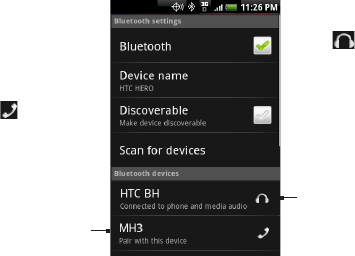
Getting Connected 119
The icon
represents that the
device is a stereo
Bluetooth headset
(A2DP Bluetooth
profile).
You need to use a
stereo Bluetooth
headset (A2DP
Bluetooth profile) if
you want to listen
to music through a
Bluetooth headset.
The icon
represents that
the device is a
mono Bluetooth
headset
(Headset and
Handsfree
Bluetooth
profiles).
Notes • Pairing between two Bluetooth devices is a one-time process. Once
pairing is created, the devices can recognize the partnership and
exchange information without entering a passcode again.
• If you pair with a second headset while connected to the first, the
first headset will be disconnected. To switch connection back to the
first headset, you must manually select that headset again in the
Bluetooth devices list.
Disconnecting a Bluetooth hands-free headset or car kit
Press HOME > MENU, and then tap Settings.
Tap Wireless controls > Bluetooth settings.
Navigate to the Bluetooth devices section, then press and hold
the connected hands-free headset or car kit.
4. Tap Disconnect.
1.
2.
3.